2014 CCT-US Expedition Scholar Blog
Thursday May 8th: Meaning and value of the Chagos Expedition
Most coral reefs around the world are in decline, and some are already severely degraded such as in the Caribbean. Near-pristine reef areas and Marine Protected Areas are very valuable tools in the efforts to save reefs. Near-pristine reefs provide a standard by which we can measure what we have lost. They provide the minimally disturbed baselines we desperately need to know what natural reefs are like, so we can know what our restoration goal is: the closer we can get reefs to the way natural reefs are, the better. Some things, like the loss of big fish, happened so long ago on many reefs that until recently we had no idea how degraded most reefs are in that respect. There are very few pristine reefs left, and there are some significant differences between those we do have, so we need every one to get a better handle on what natural reefs are. Another aspect is that Marine Protected Areas (MPAs), like Chagos, can retain good populations of species, which can produce larvae that can re-populate other areas. Further, the ability of a MPA to protect species or provide larvae for other areas depends in part on the size of the MPA. Chagos is certainly the largest MPA in the Indian Ocean, indeed, the largest on Earth, and has much better stocks of easily impacted aspects such as overall fish biomass and large fish biomass.
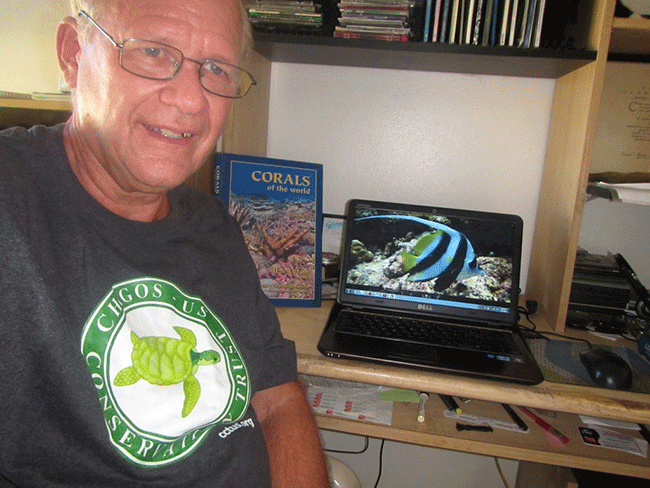
Doug Fenner, 2014 CCT-US Expedition Scholar
It is not necessary to know what every reef species is in an area in order to protect that area, and protection should not be delayed until the species are known. However, knowing the species of corals, fish and other animals helps scientists in their other work, since they need to know what the species they are studying are. For instance, we need to know which coral species are being affected by which diseases, and we need to know if the decline of a species is due to disease or other factors. I am contributing to the cataloging of coral species in Chagos by adding 32 species to the list of species known there. Further, I’m improving our knowledge of the names of some of the species by updating or correcting some of them, including common (and thus important) species such as the large green tables (Acropora paniculata which has been considered A. cytherea in Chagos in the past, a very similar species) and the bushy clumps of Acropora (A. vermiculata). I’m also contributing to the knowledge of what diseases are present in Chagos and which species of corals they affect.
This expedition has contributed vital knowledge of the reef health of Chagos by documenting the significant increase in coral disease. In addition, documenting the different kinds of disease and which coral species they infect is a very important first step toward understanding coral diseases in Chagos. Studies of prevalence of diseases and changes in their prevalence require the ability to identify both diseases and corals. These are basic first steps which more detailed studies can be built on, such as the effects of the diseases on coral populations and possible causes for the diseases. An important aspect is to document what diseases are now present in very remote, near-pristine reef areas. It appears that coral diseases are exploding around the world, and expanding from areas around people to remote areas. If that’s the case, we need to know it and document it. We don’t understand why, but we can’t understand it until we document the basics, including in remote areas.
One of the things that I will be doing will be to write descriptions of each coral species, and pick out pictures from among the 3,000 photos that I took. These will then be used as the building blocks to create an electronic guide to the corals, using the “Coralpedia” software that Charles Sheppard and others created for Caribbean species. One of the expedition members, Dr. Elizabeth Widman, will assemble the pieces into the Coralpedia program, and it will be put on the Chagos website. This will be a very useful tool for scientists who work on the coral reefs of Chagos, since they can figure out the corals that they saw, photographed, and studied. It is important for scientists to be able to identify the species they work with, so this should be a very useful tool supporting research on Chagos reefs. The Coralpedia format will allow adding more species and photographs and updating descriptions, so it can continue to grow over the years. Knowledge of the coral species also helps researchers elsewhere, since some species are common and easy to study in Chagos that are rare or absent elsewhere. For instance, the photograph shown as Ctenella chagius in Veron (2000) was not taken from Chagos, and appears to be another species (Gyrosmilia). Photos from Chagos, which are certain to be correct, were taken and will be very helpful for coral taxonomy and identification outside of Chagos as well as in Chagos.
In addition, I will write descriptions and pick out pictures of coral diseases from among photographs. The description and these images will document which coral species are affected by which diseases. This will provide the building blocks for a Coralpedia-type guide to the coral diseases of Chagos. Again, this will support the important work on coral diseases in Chagos and elsewhere.
It was an honor and a privilege to be sponsored to go on this trip, to be able to do the science and support the conservation of the Chagos Archipelago. The results of these studies and the advocacy of conservation in the blog and elsewhere, are part of a much larger effort to save coral reefs, both in Chagos, throughout the Indian Ocean, and around the world. I wish to express my deepest appreciation to my sponsors, The Kayne Foundation and The Schnormeier Foundation, as well as the CCT-US members, and lastly of course, the CCT-US. Without them, this would not have been possible. I will be now be busy analyzing results and writing a full report, and will continue to do all I can to support the conservation of Chagos and the world’s reefs. Coral reefs are immensely important to people around the world, and we must do all we can to make sure that they continue to be healthy so they can provide those benefits, including the beauty and complexity that inspires us all. I thank you for the reefs, and for the millions of people dependent on those reefs.
Thursday May 1st: All creatures great and small
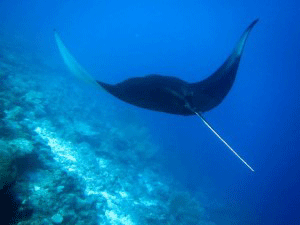 |
Manta ray |
Today is our last day of diving in Chagos. The ship is docked in the small boat harbor in Diego Garcia. This morning we set out to dive on the outer slope at the mouth of Diego Garcia, on the outside of a small island called “Middle Island.” Once the inflatable boat got there, we put on our dive gear and went down and swam over to the deep slope, which goes down at about a 45 degree angle. We had just started down it when we were surprised by a huge manta ray swimming leisurely past us. We swam after it and were able to get closer. I got my camera going and took pictures as we approached it. Then I took some video, and then a couple more pictures. When we stopped swimming, it was soon gone and we were left looking at each other like, “Oh my gosh, did you see that? Was that real?” We took nothing, we touched nothing, but we were truly touched by it and we left only bubbles.
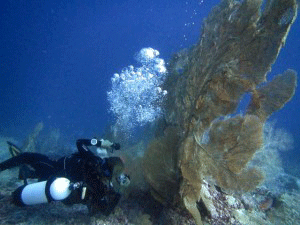 |
Giant sea fan |
Then we continued our dive on the slope, and quickly found a sea fan that must have been over 2 meters tall. I had a couple of butterflyfish around me that were checking me out, even nibbled at my pencil to see if it tasted good. We worked our way up the slope, and on top of the reef where it is nearly flat and about 30 feet (10 meters) deep, we saw a large Porites coral that formed a hill about 2 meters high and 3 or 4 meters wide. About the same time, I looked down and saw some tiny fish hovering over a coral, ready to dart between the branches to hide if a large fish (or diver) swam by. And on the bottom I saw juvenile corals, a variety of small sizes.
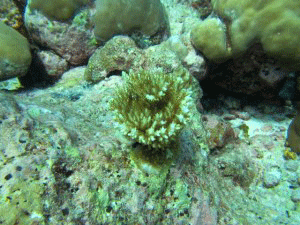 |
Juvenile table coral |
The juvenile corals indicate that there are new, young corals to replace the larger corals as they get old. I was seeing the reef creatures, both great and small. They are all part of the reef, all parts of a wonderfully complex community of wild organisms which need each other. They also need us, more than we need them. They need us not to destroy them. Surely, surely, that is the least we can do for one of the world’s most diverse and complicated and beautiful ecosystems (coral reefs), from which hundreds of millions of people all over the world benefit (from food, shoreline protection, tourism, etc.).
Saturday April 26th: Solid surprises
Corals come in a wide variety of shapes, such as the tables that we I have been talking about in my previous posting, staghorns and other branching corals, encrusting corals, plates, and rounded or boulder-shaped corals. We’ve seen the big Porites boulders and talked about how they have growth rings. We also saw some pictures of corals which have large polyps and sometimes brilliant red tissue.
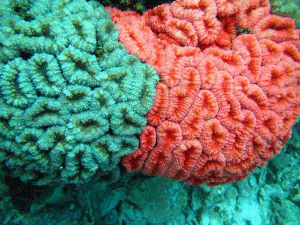 |
Two rounded Lobophyllia colonies |
The latter are in a genus called Lobophyllia. Lobophyllia commonly forms boulder-shaped colonies as it grows, and I’m including a photo of a small colony that is boulder shaped. Boulders are solid, right? So these Lobophyllia colonies are solid, of course. Ah, but take a look at the second picture, a colony that I found that had been broken. Turns out that Lobophyllia is a fooler, inside it is not solid, it is made of radiating branches, which only have live tissue on the end, and which form the shape of a boulder, but the colony is actually branching. Interestingly, such a colony began from a single larva that settled, and grew into what is structurally a single colony.
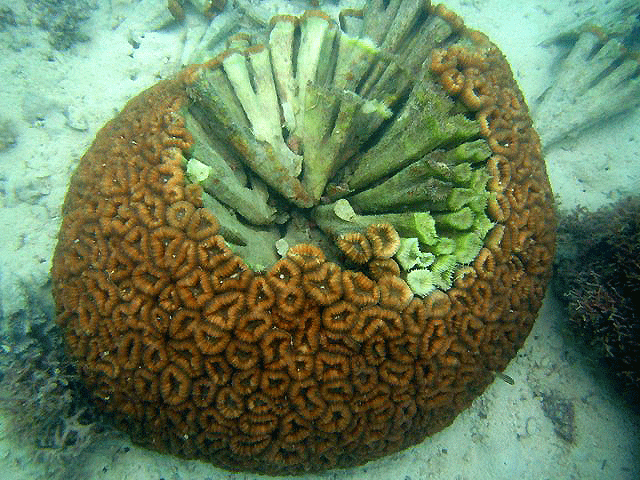
Lobophyllia surprise
But notice, the live tissue on the end of one branch is not connected to the tissue on any other branch. Hmmmm. What is an individual here? Polyps are not connected to each other, they are genetically identical, so they are clone mates, but the tissue of each polyp is separate from other polyps. Doesn’t that make each polyp an individual, and the group that we thought was a colony is a clone of individuals? Corals seem to delight in violating our preconceptions of what individuals are. But their lifestyle works for them. After all, the huge reefs like the Great Barrier Reef are the largest things on earth built by living things, far exceed anything built by humans. Not bad.
Friday April 25th: A new slant on coral growth
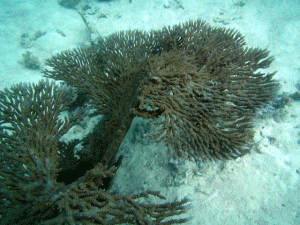 |
Table coral on edge |
Table corals grow flat like a table. Hence the name. Chagos has lots of them. A few of them aren’t horizontal, though. Apparently, their base may not always be attached to something sturdy. When a storm produces larger waves, the wave surge may topple a table that is not attached to a secure foundation. The column itself is very hard and strong and rarely breaks. But some places we found some of the tables had tipped over, but were still alive.
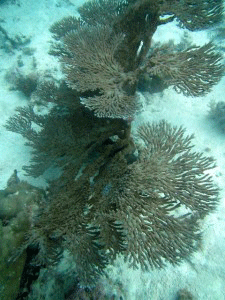 |
Table coral on edge |
Table corals survive being tipped over just fine. In fact, sometimes a table gets completely dislodged and turned upside down. If they survive the process of getting flipped, they are still alive and can survive upside down for a long time. So they are pretty good at surviving being moved. The interesting thing is what happens when a table coral gets tilted. The table grows only along its edge. What happens is that it continues to grow along its edge, but it grows horizontally, that is horizontal to reality, not straight out from the edge of the table. So depending on how much it was tilted, the new growth is at an angle to the original table. We saw this quite a few times.
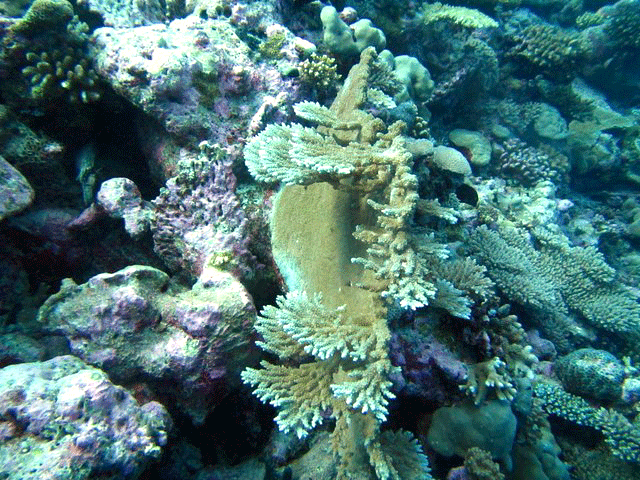
Another table coral
This makes some sense. Corals contain algae cells which photosynthesize in light, making sugar, some of which leaks into the coral cells and feeds them. This makes corals function like plants. So, not surprisingly, they grow a bit like plants. The coral itself is an animal, yet it grows attached instead of moving around. It also grows in a way that maximizes how much light it catches, in a flat surface, much like a large leaf. It also grows oriented toward the sunlight such that it is horizontal to it, and thus maximizes the light it catches. I call corals “honorary plants” or “plantimals.” You gotta admit, they are a bit different from your ordinary person, cat, dog, or fish. That’s part of the fun.
Thursday April 24th: Algae farmers
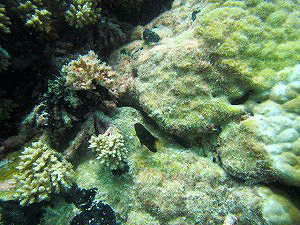 There are some damselfish which are algae farmers. Damsels are relatively small fish, and actually anemonefish are a type of damsel. There are many kinds of damsels. A few of them farm and eat filamentous algae. There are species in the Caribbean that do it, where their farming practices were first described, and there are different species which do it in the Pacific and Indian Oceans. In the Caribbean and in American Samoa, they prefer to grow their algae gardens on branching staghorn corals. They bite the polyps off the lower branches of the staghorn coral to kill it. Then filamentous algae or turf grows there. It is composed of tiny filaments which are strings of algae cells. Filamentous algae grows rapidly, and has no chemical or mechanical defenses, so herbivorous fish like to eat it. The filamentous algae spores settle on the dead coral skeleton quickly and begin to grow.
There are some damselfish which are algae farmers. Damsels are relatively small fish, and actually anemonefish are a type of damsel. There are many kinds of damsels. A few of them farm and eat filamentous algae. There are species in the Caribbean that do it, where their farming practices were first described, and there are different species which do it in the Pacific and Indian Oceans. In the Caribbean and in American Samoa, they prefer to grow their algae gardens on branching staghorn corals. They bite the polyps off the lower branches of the staghorn coral to kill it. Then filamentous algae or turf grows there. It is composed of tiny filaments which are strings of algae cells. Filamentous algae grows rapidly, and has no chemical or mechanical defenses, so herbivorous fish like to eat it. The filamentous algae spores settle on the dead coral skeleton quickly and begin to grow.
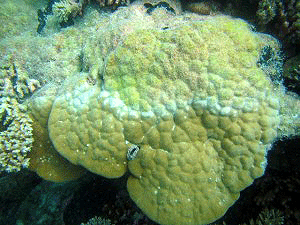 The damselfish defend their algae gardens, chasing off any other fish that might eat it, and even pick up sea urchins by their spines and drop them outside their garden to keep them from eating their garden. When the algae has grown enough, they eat it. I’ve read they even weed it, picking out types they don’t like. In American Samoa and in Chagos, sometimes, they set up their algae garden on part of a Porites boulder coral. The first photo shows the algae garden on the top half of the boulder. The white area between the algae and the healthy coral is where the damselfish has been biting the polyps off the coral to expand its garden. Over the years, I’ve learned to recognize these signs, even though it looks a lot like a disease, it’s not. So I wait a few seconds with my camera ready, and catch the farmer damsel in the second picture. Farmer damsels are usually dark, maybe they don’t want to call attention to themselves. If you watch for a while, you’ll see it chase off other fish.
The damselfish defend their algae gardens, chasing off any other fish that might eat it, and even pick up sea urchins by their spines and drop them outside their garden to keep them from eating their garden. When the algae has grown enough, they eat it. I’ve read they even weed it, picking out types they don’t like. In American Samoa and in Chagos, sometimes, they set up their algae garden on part of a Porites boulder coral. The first photo shows the algae garden on the top half of the boulder. The white area between the algae and the healthy coral is where the damselfish has been biting the polyps off the coral to expand its garden. Over the years, I’ve learned to recognize these signs, even though it looks a lot like a disease, it’s not. So I wait a few seconds with my camera ready, and catch the farmer damsel in the second picture. Farmer damsels are usually dark, maybe they don’t want to call attention to themselves. If you watch for a while, you’ll see it chase off other fish.
Wednesday April 23rd: Living together on coral reefs
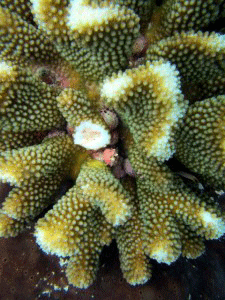 |
Parasitic snails |
The organisms on coral reefs live together in an incredibly complex web of relationships. Some species compete for resources, such as different fish that eat algae, and corals that compete for space and light. Animals eat other organisms, anything from eating algae (herbivory) to eating plankton to eating fish to eating invertebrates or eating detritus or bacteria. Fish species can be organized by taxonomic relationships into genera, families and so on, or they can be organized by functional groups: herbivores, planktivores, piscivores, invertivores, detritivores, corallivores, etc. These can in turn be organized into “trophic levels” where at the bottom are herbivores, next up are piscivores that eat herbivores, next up are larger piscivores that eat smaller piscivores. Many species have mixed diets, and the diet can change as the species grows in size. They can also be organized by size, with large numbers of small species, medium numbers of medium sizes, and small numbers of large fish.
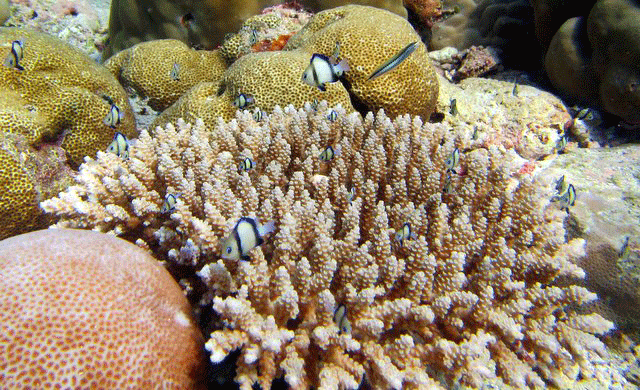
Damsels
Species can also have other kinds of relationships. Some species live together and help each other, which can be called “symbiosis” but more precisely can be called “mutualism” since the benefits are mutual.
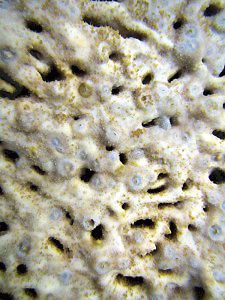 |
Barnacles in coral |
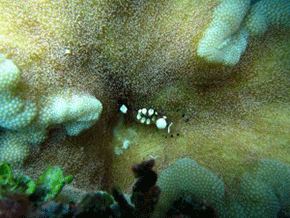 |
Shrimp on anemone |
Other species simply live on the surface of other species and neither harm nor help the host, and are called commensals. Still others live on or in the host and harm it, and are called “parasites.” In one use of terms, mutualists, commensals and parasites are all considered “symbionts.” Predators are similar to parasties but don’t live on or in their hosts, and often kill the hosts. Infectious diseases are microbes and can kill their hosts.
Coral reefs have examples of all of these types of relationships.
Mutualists: anemonefish, small fish in coral branches, crabs in coral branches, zooxanthellae in corals
Commensals: shrimp on cushion starfish, shrimp on anemone (?), clams burrowing in coral (?), feather duster and fan worms on coral
Parasites: smooth snails on corals,
Infectious diseases (microparasites): fungus, ciliate protozoa, bacteria, viruses
Predators: fish biting on coral, fish eating other animals
Tuesday April 22nd: Colors
As I said before, as a photographer I can’t resist beautiful colors. So here are a few for fun.
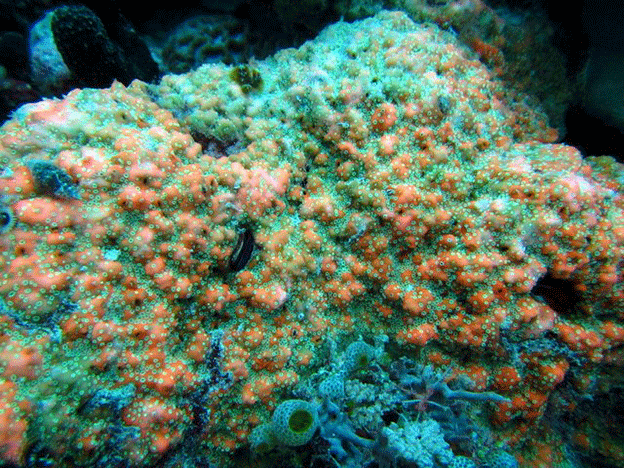 |
Hard coral Montipora |
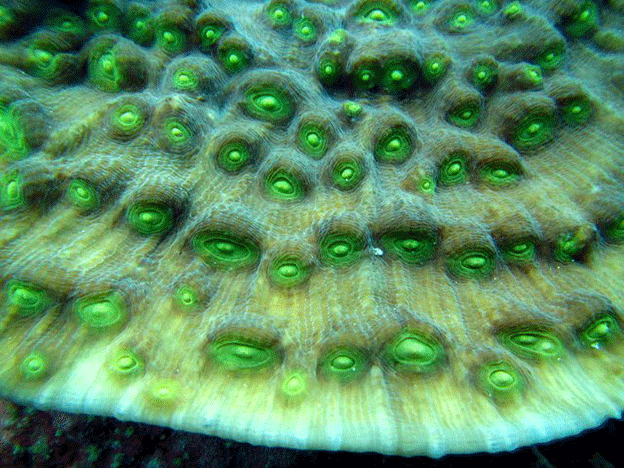 |
Mycedium elephantotus |
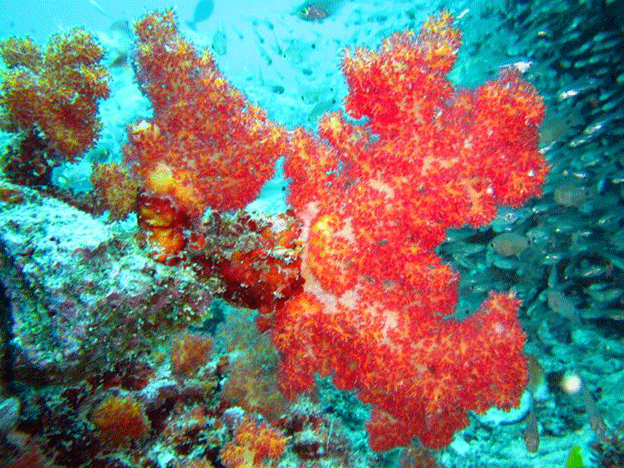 |
Soft coral |
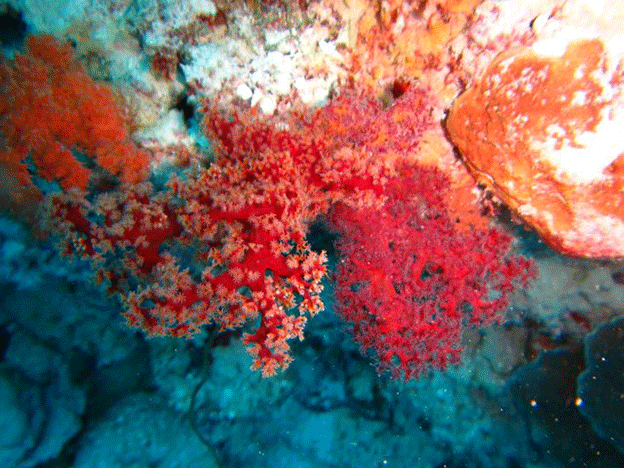 |
Soft coral |
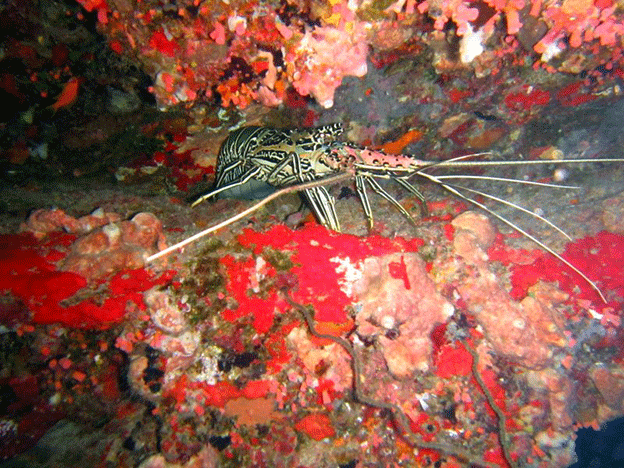 |
Lobster |
Monday April 21st: Soft corals
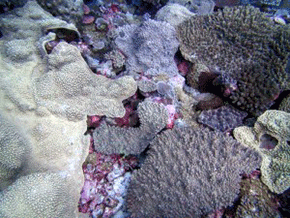 |
Soft corals |
I study the species of hard corals. However, there is another whole group called “soft corals.” These are corals that don’t form a hard skeleton like hard corals. Further, they always have exactly 8 tentacles, while hard corals have tentacles in multiples of 6. Some soft corals have single celled algae cells in them, just like the hard corals that build reefs. Soft corals that have algae in them tend to be relatively dull colors like brown or grey, and they tend to be relatively flattened so they can catch lots of sunlight. They are found in sunny locations. Other soft corals do not have the algae cells, and they tend to be bright colors, they are often tree-shaped, and they are usually found in shaded locations.
Soft corals are much fleshier than most hard corals. Instead of a solid skeleton, they form small spines made of calcium inside their tissues. I was able to get a picture of some spines left after a portion of a soft coral was killed by disease.
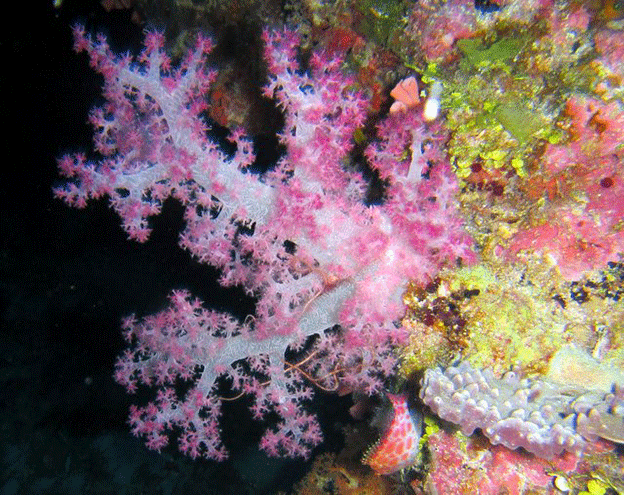
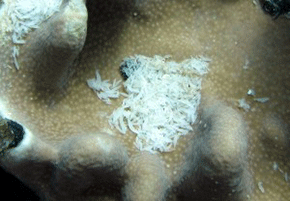 |
Soft coral sclerites |
In some soft corals, the spines are continuously moved lower in the colony, and accumulate at the base of the colony, where they are cemented together into a solid base for the colony. The base is usually flattened with an undulating, smooth surface and very solid. In a few species, the base is continually added to so much that it becomes a tree-like shape, up to about 2 m tall. In some places these bases actually contribute significantly to the building of the reef.
Sunday April 20th: Diseases on coralline algae
Coralline algae is a kind of plant, more specifically a “red algae.” It does photosynthesis in the presence of light and grows, like other plants. It is unusual in that it secretes a hard calcium skeleton, just as corals do (though solid and not porous like a coral skeleton). Hence the name, “coralline algae,” because it is hard like coral. Some kinds of coralline algae are encrusting, just as some corals are. Encrusting coralline algae forms smooth surfaces which are usually pink or purple, but less commonly can be other colors. They are most easily distinguished from coral by the fact that they are smooth and don’t have the polyp cups possessed by coral, and coralline doesn’t have spines. They feel hard and smooth to the touch. Touching them doesn’t hurt them. Touching corals doesn’t hurt them, either, if you don’t break them, and you don’t touch them many times a day (as can happen in a place with lots of divers). Anyhow, coralline algae help build coral reefs, along with corals. When they are abundant, they can sometimes even contribute more to building reefs than coral. At the reef crest, where the waves break, coralline algae dominates in some places, because if the waves are large enough they can break coral and only the coralline algae can survive unbroken. So coralline algae is important for reefs, almost as important as corals.
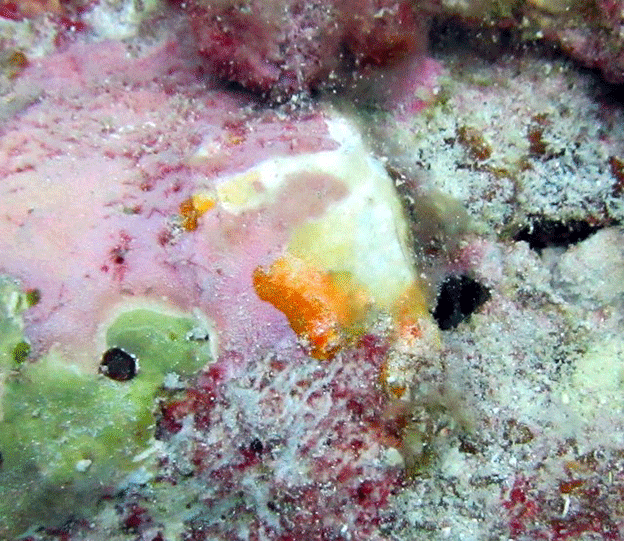 |
CLOD |
Coralline algae can get diseases, like corals and most other organisms. A while back, a bright orange bacterial disease was discovered on coralline algae in the South Pacific. The discoverers reported that it began in the Cook Islands, and spread westward to American Samoa and then Fiji, and killed a lot of coralline algae in Fiji particularly. It is recognized by a bright orange band of bacteria, which leaves dead white calcium as it moves across pink or purple coralline algae. They called it “Coralline Lethal Orange Disease” or “CLOD”. We have limited information about where this disease exists, that is, its geographic range. I saw two small orange areas on coralline algae during the trip, the first looked like it could be the orange disease, but it wasn’t all that obvious whether it was or not. The second was quite clear, showing the orange band followed on one side by white where it had killed the coralline algae. I’m used to it, since it is fairly common some places in American Samoa. It has turned out not to be a threat, even where it is most common in American Samoa, the coralline algae grows back as fast as the orange disease can kill it. But this is the first report of this curious disease from Chagos, and perhaps the first report of it from the Indian Ocean.
Saturday April 19th: Predation on corals
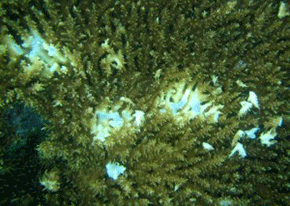 |
Predation |
A variety of animals graze on corals. Several kinds of butterflyfish nip tentacles off of corals and eat them. Some pufferfish bite corals, leaving narrow scratches where their upper and lower jaws bite the coral. Most parrotfish eat algae, but some of the larger species also bite coral, scraping polyps off of the skeleton. Such scraped areas on coral virtually always recover. The marks that fish leave on corals are called “feeding scars” although the corals usually recover rapidly, not leaving a permanent scar. Many of the bites are on Porites corals, which are named for their porous skeletons. The living tissue not only lives on top of the skeleton, but also down in the pores a couple millimeters down from the surface. Fish bites can take off the top layer of tissue and even a
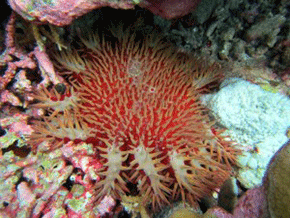 |
Crown of thorns starfish |
bit of skeleton, but don’t go deep enough to get all the tissue. The tissue below just regenerates the lost tissue, and the area doesn’t die. Some fish like to bite branches off of branching corals. White areas where branchlets have been bitten off by fish are fairly common on table corals in Chagos. The largest species of parrotfish, the bumphead parrots, have powerful jaws that can bite off chunks of coral. They eat both algae and coral in roughly equal amounts. Small fish, crabs and shrimp that live among coral branches eat coral tissues, but don’t leave easily visible feeding scars.
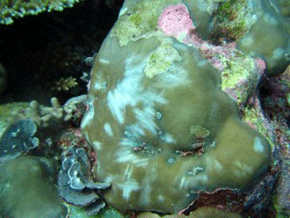 |
Feeding scars |
Some invertebrates eat corals as well. One kind (Drupella) of snail eats coral, and when it eats the coral, it removes all the living tissue from the coral, killing the area where the coral was eaten. We certainly saw it in our dives on Chagos, yet the numbers of snails were relatively small and they didn’t appear to be doing much damage. In a few places other than Chagos, there have been outbreaks of these snails that have done quite a bit of damage. A second invertebrate, the crown-of-thorns starfish, is notorious for eating coral. These starfish grow up to a meter (3 feet) in diameter. They evert (turn inside out) their stomachs out their mouths (like many starfish do to eat) and digest all the tissue off of corals, killing them. There have been many outbreaks of crown-of-thorns starfish,
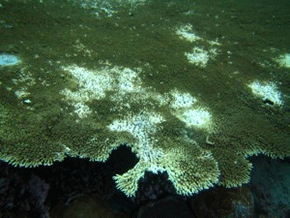 |
Predation |
and they have done a huge amount of damage on the Great Barrier Reef and Japan, but also other places. In American Samoa, they ate over 90% of all corals in 1978, and most of the corals have recovered since then. They also ate lots of corals in one small area of Chagos in past years, around Eagle Island on Great Chagos Bank. We saw no crown of thorns there or their feeding scars, so it appears the outbreak is completely over. There still weren’t a lot of living adult corals in that area this year, though there are a fair number of relatively newly settled corals. So hopefully the corals there will recover in the coming years. Outbreaks around atolls are quite rare, probably because there is very little nutrient runoff to fuel an algae bloom that would feed starfish larvae.
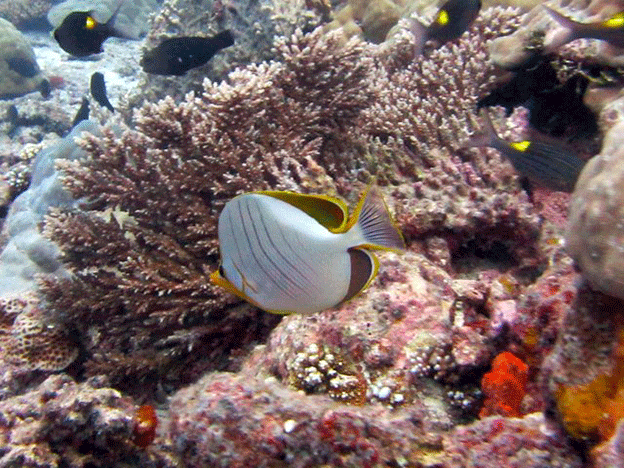 |
Butterfly fish |
Although quite a few fish and invertebrates eat coral, the effect normally is a bit like cows eating grass, as long as there are not too many, the grass can grow back as fast as the cows eat it.
Friday April 18th: When the going gets tough, the tough change sex?
Anthias are small fish that school on reefs. They eat tiny bits of plankton in the water, and so often like a place with a bit of current, which brings them food. They seem to be pretty attached to one site and stay there, instead of cruising around the reef like some schooling fish do. In one species that is common in Chagos, most of the individuals are bright orange, as shown in the first picture. Those are all females. In the second picture, you can see an individual that is in the lower center, which is purple with a light area. That is a male. A school will typically have many females, and a few males. There are coral reef fish in which one male has a harem of females. But in this species, there are several males and many females, all in one school. Experiments carried out in aquaria found that if one male is removed, one of the females changes sex into a male! They keep a constant ratio of males to females.
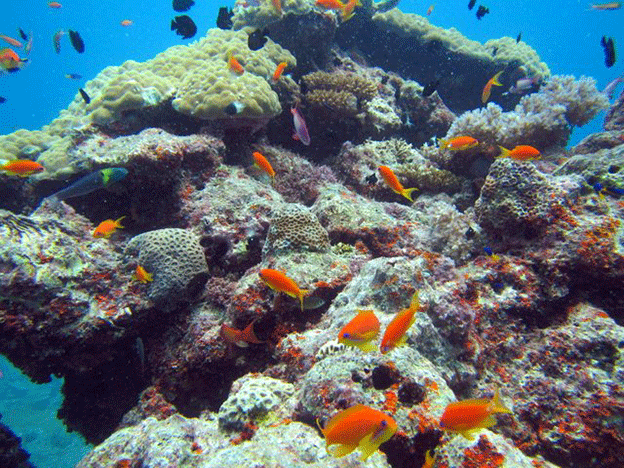 |
Female anthias |
Earlier in the expedition, I wrote a blog that talked about the Chagos anemonefish and had a picture. Anemonefish stay in or close to, an anemone. The anemone has the ability to sting most fish, but the anemonefish is immune to the sting. The anemone is a safe place, since other fish must stay away from it or get stung. So an anemone is an island of safety for an anemonefish. Some species of anemonefish are almost always down snuggling in the anemone tentacles, and other species may swim as much as a meter above or to the side of it. But they can’t go far away without risking getting eaten. So if you are a young anemonefish, and you settle on an anemone, and you are one sex, you had better hope that the anemone already has an anemonefish of the opposite sex on it. Otherwise you are not going to leave a long line of descendants. But they have a solution to this problem. An anemonefish that has been on an anemone and grown to full size will be a female, and a young anemonefish that lands will mature as a male. However, if you remove the older (and usually larger) female, and a small young fish settles, the larger fish will change from a male to a female, and the young fish will mature as a male. Pretty slick trick.
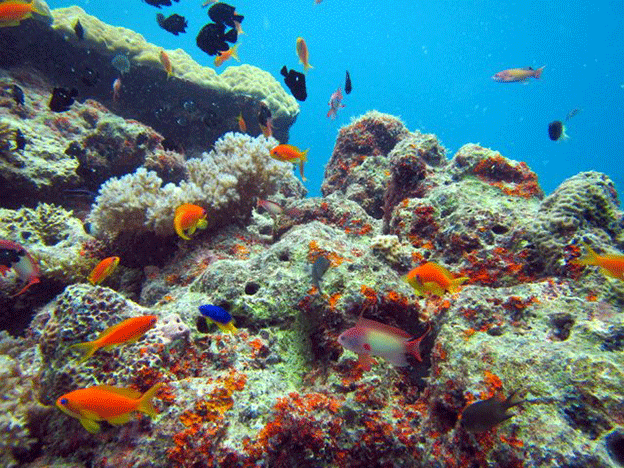 |
Male and female anthias |
There are also small gobies that live in the branches of corals, hiding deep in the branches. Turns out they are the masters of sex changes, they can change either direction, and do so repeatedly, if necessary to match whoever is in their coral. Their coral is an island of safety, they can’t leave it to find someone of the opposite sex.
Thursday April 17th: Competition for space
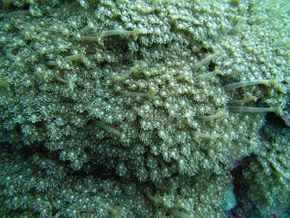 |
Sweeper polyps |
Everything living attached to the reef must compete for space. They compete for places to attach, and for access to sunlight. Corals must compete with the many different kinds of algae, and corals compete with other corals. Corals have tiny stingers in their tentacles. They are the same kind of stingers that are in the tentacles on their relatives, the jellyfish. Some of the jellyfish can inflict very painful stings, a few can even kill people. One, the box jellyfish which is sometimes common along the northeast coast of Australia, can kill a person faster than any other venomous animal on earth! Fire corals can inflict a mildly fiery sting, which usually goes away in 15 minutes or so (I speak from experience). But the stingers of all other kinds of coral can’t penetrate human skin. They can, however, sting other corals. When different kinds of corals touch each other, usually one kind has nastier stings than the other, and can fend the other off, literally killing the other’s tissue that it can reach. Sometimes when this happens, a slow growing coral with powerful stingers can keep a faster growing coral from growing over it, but the faster growing coral can grow around the coral with powerful stingers. I saw a couple such cases during my dives and got pictures.
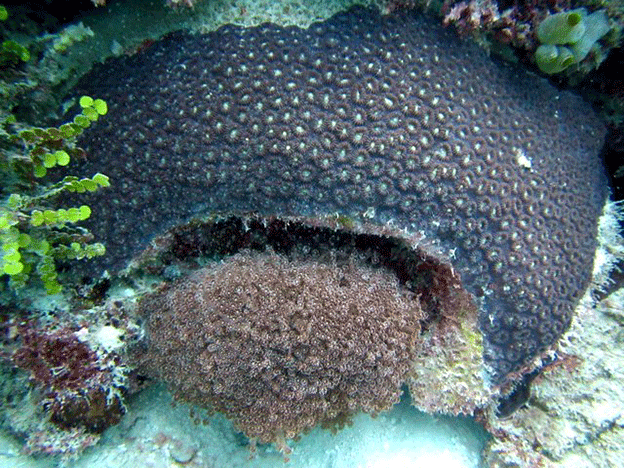
Another way that corals can battle it out is to grow longer tentacles or longer polyps to reach a nearby coral and sting it. I saw at least one colony in which a few of the polyps were extra-long and probably grew in order to attack a nearby coral. I got a picture of that as well.
Wednesday April 16th: Growth rings
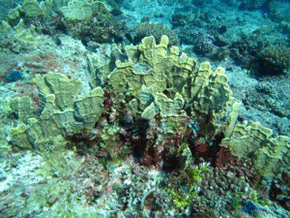 |
Millepora platyphylla |
On rare occasions, it is possible to see growth rings on coral colonies. Table corals begin like all corals as a single polyp. That polyp partly divides into 2, then 4, and so on. The polyps spread out across the substrate. When they reach an area of about 10-20 cm diameter, then they start growing upward in the middle. They grow in the shape of a column, until they reach about 10-20 cm high. Then the polyps on the top start growing outward on the edge of the top surface of the column. They are then forming the table top. On the table top, all growth is on the edge. Scientists have discovered that sometimes, the angle that the edge grows outward varies slightly with seasons. Maybe the edge grows outward and just slightly upward during the summer, and flat or slightly downward in winter. Or vice-versa, I don’t know. But the net result is slight ripples, one ripple for each year. On a circular table, it ends up forming concentric circles. I looked at hundreds of table corals during this trip, and only saw one with these annual growth ripples. I got a photo.
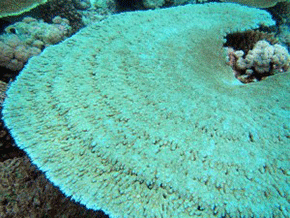 |
Acoropora clathrata growth rings |
Fire corals are corals which can give a mild burning sting. A species which grows as flat vertical plates or blades in the Caribbean has been found by scientists to produce annual growth bands. These bands are places where the blade is slightly thicker, and since the upper edge of the blade is where growth occurs, they are parallel to that upper edge of the blade and so horizontal. This has not been reported from the Indo-Pacific to my knowledge. I found some colonies in Chagos of a species that forms flat vertical plates. The plates often had narrow ridges that were horizontal or nearly so. However, they did not have even spacing as one might expect for annual bands. What forms these bands are a bit of a mystery to me at this point. Coral reefs are FULL of unexplained mysteries, and particularly in the Indian and Pacific Oceans, where the diversity of organisms is high, it is pretty easy to find something that hasn’t been reported before. To a scientist like me, being able to discover things is like being in a candy store!!!! It is perhaps the most exciting thing we do as scientists. I love the “natural history” of coral reefs, by which I mean keeping my eyes open and noticing new things, and then hopefully figuring out what is going on. Another aspect of the study of ecosystems is the quantitative experimentation and mathematical analysis of large sets of data, looking for the universal laws of how ecosystems operate. Both are exciting ways of studying nature and can reap rewarding benefits. Back before the last 2-3 decades, this is the sort of thing most coral reef scientists did, basic research. Now, much of coral reef science is directed at studying the threats to coral reefs and how they act on reefs. But much of that is built on a basic knowledge of coral reefs built up in the decades before that. Both are needed for us to meet the very real challenges and threats to coral reefs, and work to keep them from being degraded.
Tuesday April 15th: Zonation
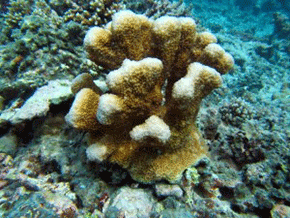 |
Isopora palifera |
Coral reefs have what is called “zonation,” where the community of organisms differs depending on where on physical gradients they are. Different species of coral are adapted to different locations on physical gradients. I try to search across zones, because I may be able to find some species in one zone and different species in another zone. Coral reefs often have obvious zonation by depth. This is why I like to search from the deep to the shallow, because I can find more coral species that way. Atolls are rings of coral that enclose a central lagoon. The ring of coral often has some islands on it, and may have one or more relatively deep passes that connect the lagoon with the outside water. The islands are made of coral sand and rubble. If the island is very temporary it won’t have any vegetation, if it is less temporary it usually has vegetation. On atolls, there are also reef areas on the outside where the reef is exposed to oceanic waves, and reef areas inside the atoll where the reef is protected from oceanic waves. Water movement from waves is one of the physical things that cause zonation. The closer a point is to where waves break on the shallowest point of the reef, the greater the water motion, and the farther from it down a slope, the less water motion. Another physical aspect that causes zonation is light. Sun light is very intense in the tropics so corals in shallow water are exposed to intense light, and the deeper in the water a coral is the less intense the light is, until there is so little light that no corals that require light can live. At our maximum safe diving depth (25 meters), there is still enough light that it looks well lit to us, but the deeper you go from there the less light and the fewer corals often. Light is also reduced where the reef slope is near vertical, and is especially reduced under overhangs on very steep slopes. One coral that I found in Chagos that is restricted to overhang roofs is the coral that forms runners like strawberries, Rhizopsammia verrilli, which we first talked about because it looks different in a picture taken with flash than a picture taken in natural light. One of the more common corals in the sunlight down at 25 meters depth is Pachyseris speciosa, which forms a thin flat plate. Many of the corals that live in light deep on the slope are thin flat plates, because that shape can catch a maximum of light, yet only a minimum of skeleton is required. Forming skeleton requires energy, and most of that comes from the light by way of the algae cells in the coral doing photosynthesis. Down deep there is less light energy to spend making a thick skeleton. At medium
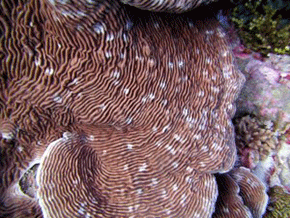 |
Pachyseris speciosa |
depths in Chagos, table corals are very common, and in some places at medium depths the rounded Porites corals that can get so big are also common. I wasn’t able to explore the shallow water where the waves crash since that’s dangerous, but I did explore a shallow area of the lagoon where the waters are calm, and a thick branching coral, Isopora palifera, was common there. The coral with the long polyps and which forms polyp balls, Goniopora stokesi, is found in the lagoon at the bottom of the slope coming down into the lagoon from islands, and it often lives on sand. This is a particularly calm area protected from wave surge. In an area of lagoon that has murky shallow water, I found lots of coral (Lobophyllia hemprichii) that makes mounds of large polyps. We first talked about that species when we talked about corals that have bright colors, which we illustrated with some very bright red corals of this species. If you live near a temperate rocky coast, you may be able to see zonation of the organisms on the rocks, with barnacles up high in the intertidal zone, seaweeds middle, and sea anemones, urchins and starfish down low. Mountains also have zonation, with one type of forest down low, other types higher up, meadows above tree line, and then at the highest altitude all the plants may be very short, in what is called “tundra” and is also found at high latitudes. So zonation is a feature of coral reefs which is also found in other places like rocky intertidal areas and mountains.
Saturday April 12th: Not a bad dive
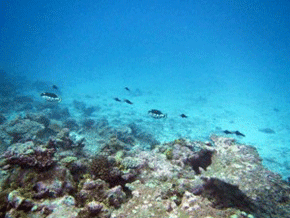 |
Clown triggerfish |
Sometimes you find interesting things on a reef that doesn’t look all that pretty. Our last three dives have been around a small island on Great Chagos Bank, called “Eagle Island.” The last dive of the three started out inauspiciously. Lots of dead corals. The reef around this island was hit by an outbreak of crown-of-thorns starfish a few years ago, which killed a lot of coral. There are still some alive, but the reef looks very drab and depressing with all the dead corals covered with fuzzy brown algae. Such areas are rare in Chagos. Oh, but what is this? A weird looking coral. I swim over and turn my camera on. It turns out to be a branching coral in genus Acropora. I have seen thousands of corals in that genus on this trip, and hundreds in this species, A. retusa. But this one is different. It has all these weird growths around the tips of the branches. We call these “growth anomalies” since they are not normal. We don’t know what causes them, but they are considered a disease.
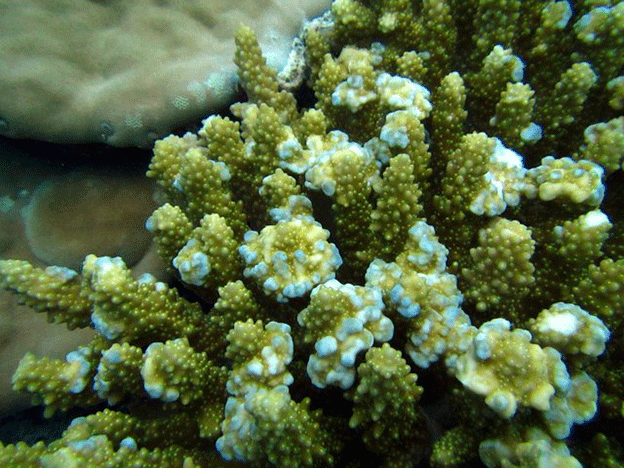 |
Growth anomalies |
The shape of these is different from anything I’ve ever seen! I capture lots of pictures. Wow, that makes the whole dive worthwhile. Just then, my buddy Sophie makes noise, and I look up to see 3 big eagle rays swimming past us.
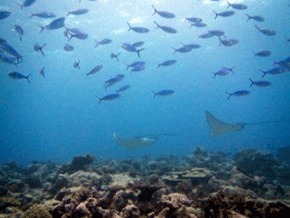 |
An amazing dive |
I take pictures, but they are not close enough to get clear pictures. A little later, I see Sophie is taking pictures of a clown triggerfish. These are beautiful fish, highly prized in the aquarium trade. Very small individuals are preferred by the aquarium trade since they do better in a small aquarium, but this is a full size adult, around 30 cm long. As I approach, I see there are a total of 3 of them. They start swimming away and I can’t get a clear picture. I do get a fair picture of a large angelfish.
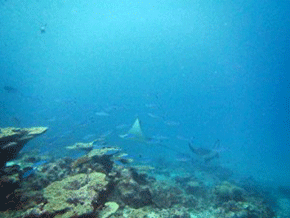 |
Eagle rays |
As I look around, I’m amazed at the number of medium size fish. After we come up and get back on the boat, Sophie tells us that she saw a hammerhead shark which came within a few feet of some of the divers. No one else saw it, we were all busy looking down at the reef collecting our data. What an amazing dive, what an amazing place!
Friday April 11th: Coral Diseases
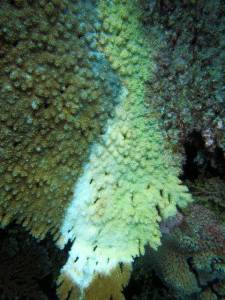 |
White syndrome |
Coral diseases have caused major damage to coral reefs, especially in the Caribbean. In the Caribbean, one disease (“white band”) killed most of the staghorn and elkhorn corals (Acropora), which were two of the three most dominant corals in the Caribbean. Those two corals have lost about 97% of their former abundance, and white band was the single greatest cause (though not the only cause). The loss of so much of two of the most abundant corals was a major part of the loss of 50-80% of the corals in the Caribbean. I can remember decades ago when no coral diseases were known from the Caribbean, now about 15 diseases are known. In the Indo-Pacific, coral disease has not done nearly as much damage so far. Fewer coral diseases have been recognized in the Indo-Pacific. However, I’ve been photographing coral diseases in American Samoa for 10 years, and now have pictures of more kinds of diseases in that tiny area than have been recognized in the whole Caribbean. Also, I didn’t see any disease outbreaks in my first years there, but I have seen a few small outbreaks in recent years. It is now widely reported that several diseases are more abundant when water temperatures are higher, and disease outbreaks have been reported after mass coral bleaching events caused by high temperatures. Water temperatures are rising due to global warming. So coral diseases have become a cause for major concern for coral reefs world-wide.
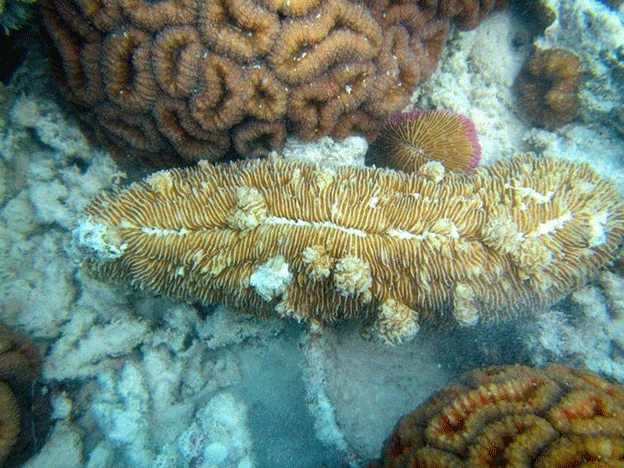 |
Growth anomalies on Herpolitha limax |
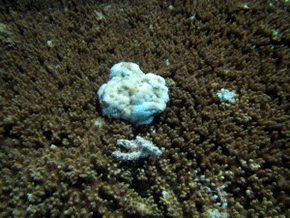 |
Growth anomalies on a table coral |
Some coral disease experts recognize three general types of coral disease, “discoloration,” “growth anomalies,” and “tissue loss” also called “white diseases.” Discoloration seems to be the least damaging to the coral and tissue loss is the most damaging and can be lethal. There are several kinds of disease of each of these types. Table corals in the Indo-Pacific are subject to a disease called “white syndrome.” A band of white sweeps rapidly across a table in a few weeks, killing much or all of it. There are a fair number of table corals with it in Chagos. Another tissue loss disease infects branching corals, killing a few branches at a time and slowly killing the colony. In American Samoa it is common on Pocillopora, and in Chagos something like it appears on Pocillopora and Sylophora. Growths on table corals are common in some parts of American Samoa, and here in Chagos they are rare on tables but a bit more common on an elongated mushroom coral. Finally, I have photographed a couple colonies here with discoloration consisting of dark brown patches, which were probably caused by a fungus growing from the skeleton up into the coral tissue. I’ve only seen two colonies with this. The cause is known for only a few coral diseases.
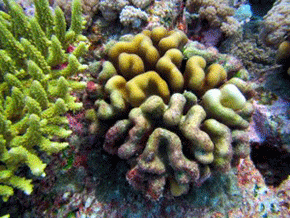 |
White disease |
Diseases are a normal part of the biology of plants and animals, including humans. In wild animals, they only become a problem when there are outbreaks. It is important to keep track of them, and particularly of outbreaks. Dr. Courtney Couch is taking quantitative data on coral disease and taking samples of diseases, and I’m taking photos of disease and sometimes counting diseases in larger areas as I record corals. Diseases are very important for the health and future of reefs, so we need to know what diseases are present in Chagos and monitor them. Only small amounts of disease were found here in a survey in 2006, at the low end of the range of disease abundance on reefs in various places. Yet we have now found a fair bit of disease, one of the most common here (white syndrome) is often lethal for infected colonies, and we have found it everywhere in the archipelago we have been. This may be in part because the corals it attacks, table corals, are so common all over the archipelago. Large numbers of hosts close together often facilitates disease transmission. Also, several coral diseases have been found to spread faster in higher temperatures and sea surface temperatures have been rising in recent decades. One or both of these factors may have contributed to this disease being more abundant now than in the past. Coral diseases will be important to monitor and investigate in the future.
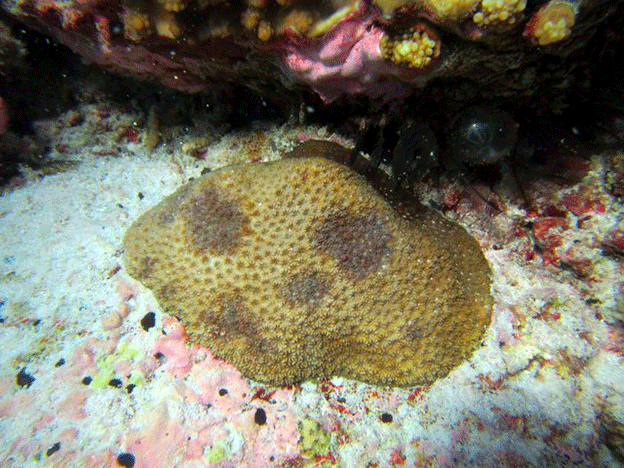 |
Fungal patches |
Thursday April 10th: A shark can be a curious animal
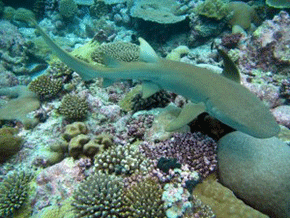 |
Tawny nurse shark |
This afternoon some of us had chosen to dive the lagoon side of Danger Island, and others the seaward side. The other team dove first, and when they returned to the boat, they told us there wasn’t a lot of coral. Also the slope was so gradual that we couldn’t get much depth range. So we radioed the people diving on the seaward side, and they said they saw lots of live coral and fish and a dropoff where they were. So we changed plans and headed over there. We got our SCUBA gear on and rolled over into the water and went down. I had just gotten to the bottom, when I was startled by something moving close to me along my side. I turned and saw it was a Tawny Nurse Shark. I’ve never seen one before, I had mentioned just earlier in the day I’d like to see one. And here it was, a few feet from me. I quick start up my camera and start taking pictures. It is a lovely animal. I’m taking pictures as fast as I can, thinking it may swim off and I’ll never get to see it again. Instead, it circles around and comes back. Meantime, my buddy, Anne Sheppard, starts taking pictures of it too. We do this for a little while, and then Anne heads off toward the dropoff to start her work down at 25 meters depth. The nurse shark follows her, and I get a picture of the shark following her. We get down on the slope, the shark is nowhere in sight, but a while later it shows up, swims around us, and goes under a table coral and settles down. We get our work done, and go back up to the boat and get in. Anne said that I had said I wanted to see a nurse shark earlier, so she showed me one (she was the one who decided to dive the outside instead of the lagoon side).
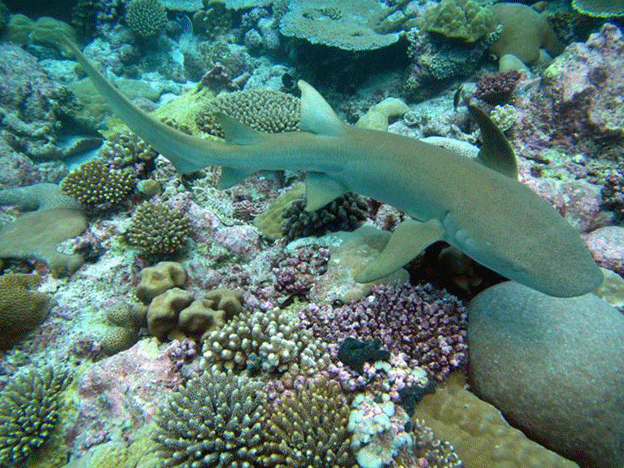 |
Tawny nurse shark |
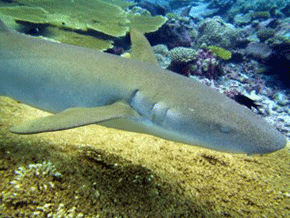 |
Closeup of a tawny nurse shark |
Nurse sharks don’t look like a dangerous shark, and don’t have a bad reputation. Sharks, and particularly reef sharks, are highly overrated for their danger. Reef sharks are way less dangerous than bee stings or lightning strikes. Of course, humans kill vastly more sharks than sharks kill people. Sharks around the world kill about 5 people a year, and humans kill about 100 million sharks a year. Plus, it is sharks like great whites and tigers that do most of the attacks on people, and attacks by reef sharks are rare. Mind you, I’ve read that pulling on a nurse shark’s tail can get you a pretty strong bite. Best to just observe and “take only pictures, leave only bubbles.” Sharks are sometimes portrayed as mindless killing machines that go into feeding frenzies. Of course, people like to be scared by big, dangerous things, and the movie “Jaws” earned a lot of money at the box office, as did “Jurassic Park.” Sadly, when a person is attacked or killed by a shark, sometimes people go out killing sharks, often killing shark species that have never attacked anybody.
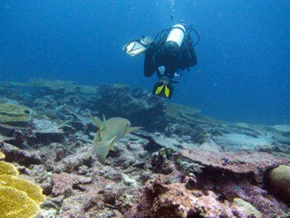 |
A tag-a-long |
Sharks are far from mindless, they are predators, and like such predators as cats and dogs can be quite curious, which is why this shark stayed around us and followed us. Far from primitive, sharks invest heavily in very large babies, as do humans. Some even have a placenta to supply food and oxygen to their fetus. Mammals aren’t the only placental animals. Sharks are top predators, and top predators are important for ecosystems. I remember as a child, being in Grand Canyon National park, and hearing the ranger point out that no trees had any needles on branches low enough for deer to eat them. The ranger explained that all predators had been killed, wolves and cougars, and that in the national park where hunting was forbidden, the deer population had exploded, and was eating everything they could reach. The result is that all saplings were browsed until dead, and there were very few young trees to replace old trees. Also, the deer were malnourished. Top predators are generally good for the species they prey on, removing the weak and selecting for strong, healthy animals, and keeping populations in check. So sharks are actually good for prey species and the reef. They are also very exciting for divers to see, and divers are willing to pay good money for the opportunity to see them. They can be important earners for small island economies. So next time you see a reef shark, enjoy the experience and the beauty of these streamlined wild animals that we are privileged to see.
Wednesday April 9th: So Who Needs Light
The earliest naturalists and scientists to study corals couldn’t figure out whether they were animals or plants, and so called them “zoophytes.” Since then, we’ve learned that corals are animals, closely related to sea anemones. A sea anemone has a short, columnar-shaped body, and on top there is a ring of tentacles and in the center it has a mouth. The under surface of the column sticks tightly so some hard surface. A single sea anemone is called a “polyp.” A sea anemone is clearly an animal, it can move if you touch it, also it eats things, and it has many other features of an animal, like requiring oxygen and producing carbon dioxide. Some corals have a single polyp like an anemone, but most have many polyps. The polyps are attached to each other in a continuous sheet of living coral animal tissue. The polyps are repeating units or parts of the coral, which we call a colony (of polyps). The coral animal also has single cell plants inside it. The single cell plants are actually inside cells of the coral animal. No wonder the early scientists were puzzled, it is actually a “symbiosis” or living together, of an animal and plants! The single cell algae can make sugar in the sunlight like any other plant. Some of the sugar they make leaks out into the animal, so the animal gets nutrition from the plants in it. Pretty slick trick. That explains why corals live in shallow, sun-lit water, and why they grow in shapes a bit like plants, and don’t need to move around like most animals. Maybe we should call them “plantimals.”
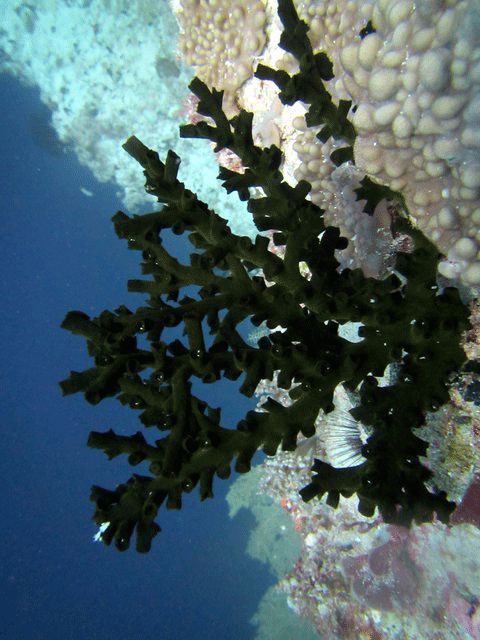 |
Tubastraea micranthus |
What I just described are the corals that build coral reefs. Actually, the reef-building corals are only about half of all the coral species. The other coral species don’t have algae cells in them. The algae help the corals grow faster, so the corals that have algae can become large, and can help build coral reefs. But they have to live in shallow water to get the sunlight. Corals that don’t have algae are usually smaller, and don’t have to live in the sunlight. They can live at most any depth. A few live on coral reefs, often in shady locations. They may live in deep water and/or on steep walls or the roofs of caverns. We’ve already seen one of them in Chagos, the coral that is orange in a picture taken with a flash, and which can grow runners. Another forms dark green or black trees. It is called “Tubastraea micranthus.” We’ve seen quite a few of them down deep on a couple of sites. This species can grow quite large, I’ve seen one in the Philippines that was 2 meters tall, with a base about 30 cm in diameter. It is one of the largest corals without algae, and it is not really clear how it can grow so fast and so large.
Wednesday April 9th: A Special Coral
Yesterday, I was happily swimming along the reef, when I spied a red coral. Now, I like pictures of brightly colored things, so I swam over and got my camera ready. I took a couple of pictures, and realized that this was no ordinary coral. I called my buddy, Anne Sheppard, over, and pointed it out to her. She tried taking a picture, but her camera wouldn’t work. Then we went on the rest of our dive, taking data and taking pictures of coral. When we were back up on the inflatable dinghy, I told Anne what I thought it was. He face lit up right away. She knows this coral because her husband, Charles, had originally discovered the species in Oman, quite a long time ago. He recognized it as a living example of a fossil coral. Another person later decided it was not the same as the fossil coral but was instead a new species of coral, named it in a publication later, and named it in Charles’ honor. A few years back, I found it in Rodrigues, which was a long ways from where it was known from. It looked a bit strange, with small fleshy polyps, and I didn’t know what it was, so I collected a small piece. When I looked at its skeleton, it was very unusual and strange, and in a few days I figured out what it was, “Parasimplastrea sheppardi.” It is the only living species known in its genus. That experience helped me to identify it here in Chagos. I think it is completely appropriate for a coral named “P. sheppardi” to be found in Chagos, since Charles and Anne have done the most of anyone to study and describe the Chagos reefs and encourage others to do so, and to work for the conservation of this wonderful area of reef wilderness.
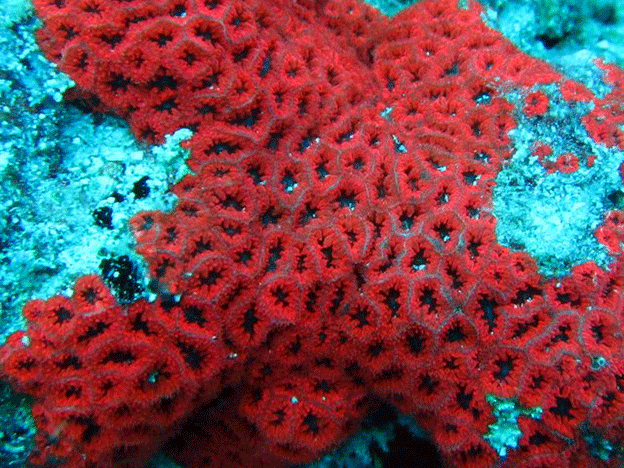 |
Parasimplastrea sheppardi |
Wednesday April 9th: Giant Corals
Corals are animals, and corals that build reefs have tiny, one-celled algae (plant) cells inside them that can make food for them. Corals are also able to make a skeleton. The skeleton is made of calcium carbonate. The coral gets the calcium carbonate out of the water; there is lots of it in seawater. The coral builds a hard, white, skeleton out of calcium carbonate. The skeleton is actually outside, below the living coral tissues. Also, it is all one piece, unlike our skeleton which has many pieces which are movable. The coral skeleton is cemented down to a hard rock substrate underneath it, in most cases. So although we call it a skeleton, it is different from our skeleton, and not used to help the coral move around like we use our skeleton.
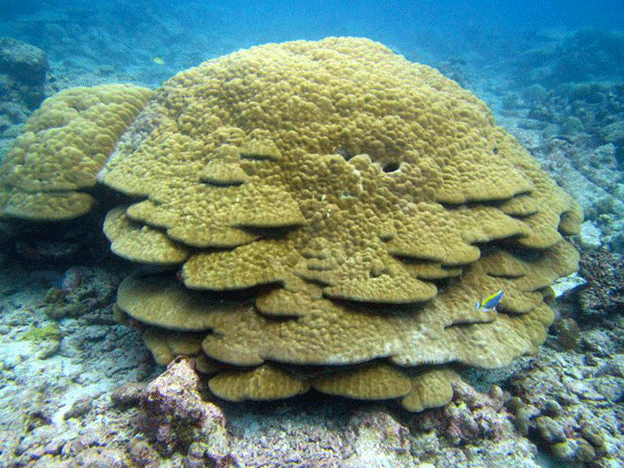 |
Giant Coral |
Corals come in a wide variety of sizes as adults. They all begin as tiny larvae developed from eggs, the eggs being the size of the head of a pin, and the larvae not much larger. The larva settles on a rock, and changes into a polyp, and starts to secrete a skeleton beneath it. The polyp divides into two polyps, those two divide into four, and so on as the coral grows. As it grows, it secretes more skeleton beneath it. Some corals don’t get very large, but others get huge. The largest type forms mounds which can get very large. The other day, we saw some coral mounds that were perhaps 2 meters tall and 4-5 meters wide. In American Samoa where I work, there is one that is 7 meters tall, and 41 meters in circumference!! In Taiwan, there is one about 12 meters tall but not as wide. These are the giants of the coral world.
They are also old. They are a little like giant trees, like redwoods or some Eucalyptus trees. Like trees, they form rings. In wood, you can see rings with your naked eyes, but in corals you have to use X-rays to see the rings. Scientists often take a slice of a coral skeleton to a hospital, to have it X rayed on their X-ray machine! In the X-ray, you can see the rings, which are typically about 5-10 mm thick. That means you can count the rings just like with tree rings and find out how old they are. With a tree, you can sample a living tree without hurting it, by taking a thin core from the tree trunk. You can do the same with a giant coral, drilling it to remove a core. The coral grows back over the hole and in a couple years you can’t even see where it was drilled. The oldest coral I know of that has been drilled is about 700 years old! That makes it one of the oldest living animals on earth. The skeleton incorporates some things in it, such as sediment.
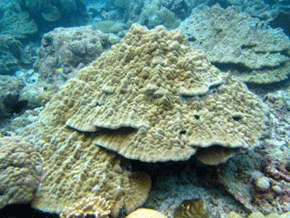 |
Giant Coral |
Coral skeletons on the Great Barrier Reef show more sediment in their skeletons after western settlers began to run cattle on the nearby land. The coral skeletons also incorporate chemicals that can be used to determine the temperature they lived in, and so can be used to reconstruct tropical ocean temperatures in the past. Much of the carbon dioxide we release into the atmosphere when we burn fuels like wood, oil, coal, and natural gas dissolves in the oceans, making them less basic and more acidic. That in turn makes it harder for corals to form their skeletons. Scientists predict that in the future as the oceans become less basic, corals will find it more and more difficult to build their skeletons. This will add to the many other impacts humans have on corals, and reefs will have fewer and fewer corals on them. There is still time to change our ways and start using renewable, sustainable, energy sources. One nice thing we know when we see these large corals is that the growing conditions for them must have been good for hundreds of years where they live now. Let’s keep the conditions good for corals around the world.
Wednesday April 9th: Threats and Impacts
Humans have done, and are doing, a lot that affects their environment. We tend to learn about things that we do to our environment the hard way, by dear experience when we find out some aspect of our environment that we used to benefit from, is now no longer beneficial. Like abundant clean air and clean water, abundant fish stocks and natural ecosystems where we can “recharge our batteries” in wilderness. The things that healthy natural ecosystems do for us are called “ecosystem services.” Coral reefs provide high protein fish for poor people in the tropics around the world, they provide shore protection from waves that can wash away the land we value, and they provide a suprising amount of income from tourism, mostly for island peoples who have little other sources of income. Not to mention the amazement and thrill of divers and snorkelers, surrounded by wild animals.
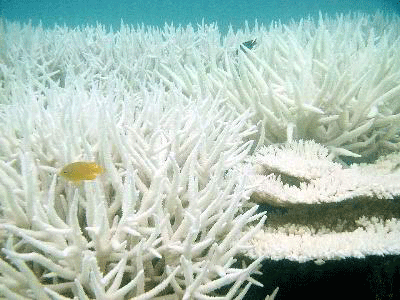 |
Bleached Coral |
Humans have done a lot that has damaged reefs, and it looks like they are going to do even more in the future. I call “impacts” the effects on reefs of things done in the past, and “threats” things that are likely to affect reefs in the future. Some things have had huge effects, others are very minor. There are lots of things humans do to reefs. Divers do damage coral reefs, there is no doubt. Fin kicks break coral, walking on reef flats can smash corals, spearing fish kills those fish and depletes their species. Hotel construction can damage reefs directly or by soil erosion into the sea. Hotel sewage can damage reefs. Done right, diving can avoid almost all impacts to a large extent. Diving also impacts only a tiny fraction of the world’s reefs. Diving is actually considered one of the very minor impacts and threats.
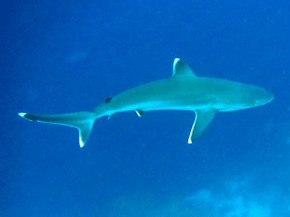 |
Silver tip shark |
So what impacts has Chagos experienced? Chagos has had vastly less impact than most reefs around the world, but it is not totally pristine. I understand from others who have vastly more experience here than I do, that there seem to be three major impacts. One is that poachers have removed a large portion of the sea cucumbers. Sea cucumbers are collected, cooked and dried, and shipped to China for eating. They are removed much faster than they can replenish themselves by reproduction. They are not all gone in Chagos, and I have been able to photograph a number of them, though I’m told there are many fewer than there once were. They don’t seem to be poached any more.
A second impact on Chagos is shark poaching. Small boats come from Sri Lanka, and poor fishermen catch sharks. Likely the fins are sold for shark fin soup in China. There are still sharks in Chagos, more than on most reefs around the world. We see one or more sharks on most dives. But the poaching continues, in spite of attempts to catch poachers. The ship we are on is used to patrol the Chagos area and try to catch poachers, as well as to be ready to rescue people in this very remote place.
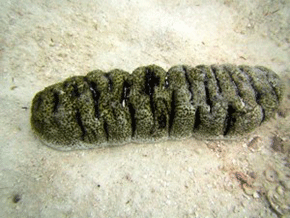 |
Sea Cucumber |
The third impact was the mass coral bleaching in 1998. In 1998, the El Niño (pronounced “El Ninyo”) phenomenon produced elevated sea water temperatures in areas scattered around the world, but particularly in the Indian Ocean. Most corals live very close to the maximum temperature they can survive. Masses of coral died in the 1998 hot oceans, including in Chagos. The wonderful thing is that although most of the corals died here that year, they have come roaring back!! The reefs are now plastered with corals, almost as much as before 1998. But there are dark storm clouds on the horizon. Global warming means that in the future, El Nino events will kill corals again, and eventually will kill them so often that reefs will not be able to recover before the next hit.
Most scientists agree that the greatest future threat to coral reefs is climate change, particularly global warming, ocean acidification, and heat-produced disease outbreaks. If we don’t do something about global warming, we will lose coral reefs as we know them in a generation. Coral reefs will become algae beds with a few corals scattered around. Some reefs already have become this, such as in Florida. We must get our societies and leaders to demand the changes needed to avoid the worst effects of climate change. It can all be done, we even know how, we just need to do it. President Kennedy said “We choose to go to the moon, not because it is easy, but because it is difficult.” We need the same spirit to commit to fixing this problem, before it is too late.
Wednesday April 9th: There's more than on way to reproduce (if you're a coral)
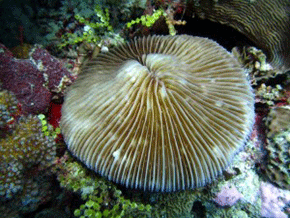 |
Mushroom coral |
Corals have more than one way to reproduce. They can reproduce sexually, but they can also reproduce asexually. Some species have two separate sexes; one produces eggs, the other sperm. In a majority of species, though, an individual produces both eggs and sperm. Such individuals are called “hermaphrodites.” Further, some species release their eggs and/or sperm into the water, where the eggs are fertilized by the sperm. This is called “broadcast spawning.” The fertilized egg then develops into a larva, and once the larva is ready to, it searches for a place to settle and start a coral colony. In other species, the egg is retained inside the parent polyp, and the sperm swims in the polyp mouth to fertilize the egg, which then grows into a larva inside the polyp, and then swims out and searches for a place to settle. This is called “brooding.” These are all variations of sexual reproduction.
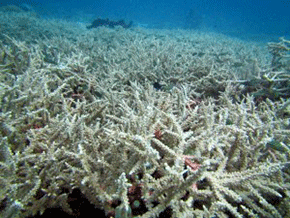 |
Branching Coral |
Many corals can also engage in “asexual reproduction.” If a branch breaks off and it lands on a hard surface, it can attach and start a new colony. The new colony will be genetically identical to the parent colony, like identical twins, and can be called a clone mate. If the branch falls into sand, it may be smothered and not survive. In some species such as the staghorn corals, branches breaking off and starting new colonies is a common occurrence, and they often form thickets of branches. A couple of species of mushroom corals actively produce cracks in their skeleton to facilitate breaking, as a way of insuring asexual reproduction. Sometimes you can find thousands of them, and most are in the process of breaking to form additional corals. In one coral, the coral puts out a short runner along the substrate, and new polyps can develop along the runner, much like on strawberries. You will recognize it as the coral that I showed earlier that looked bluish-green in a natural light photo and bright orange in a flash photo, named “Rhizopsammia verrilli.” “Rhizome” is another word for “runner.”
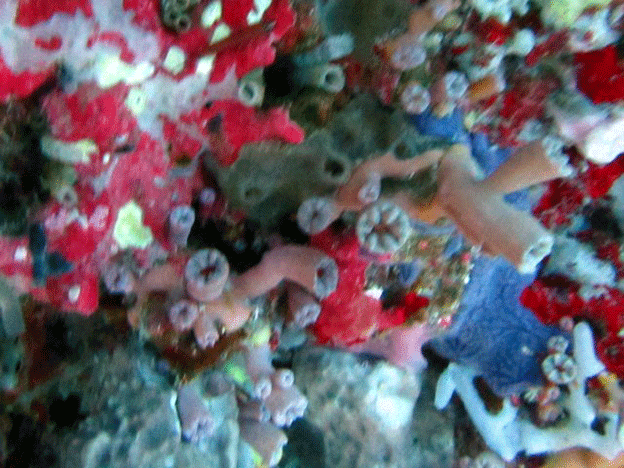 |
Coral Runners |
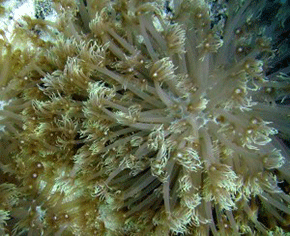 |
Goniopora stokesi |
Anne Sheppard showed me some interesting corals that have a unique way of performing asexual reproduction. These corals have polyps that look like daisies. They have a long column, and at the end they have radiating tentacles that look a bit like a flower sometimes. In this species the tentacles are long and thin and droopy, and it looks a bit more like a mop. Corals have a hard calcium skeleton, and the living coral tissue covers the skeleton and forms the skeleton. In this species, named “Goniopora stokesi,” the skeleton is a fairly small round mass, about the size of a fist. Next, they start to form a new skeleton ball inside the tissues that cover the main skeleton. In this species, the tissues form a thick, soft, water-filled layer on the outside of their skeleton. The new small skeleton ball is formed inside those tissues. The new small skeleton ball is added to and so increases in size in time. Eventually it becomes heavy enough to fall off the main coral, and start a new coral colony. The skeleton with its own polyps is called a “polyp ball.” If you find the adult coral, it looks like a mass of polyps with tentacles. If you feel around in the polyps, they start to retract and you start to feel some smaller hard balls in the tissue. Once the polyps are retracted you can see the polyp balls. This is the only species that does this, and this is only the second time in my career I have seen them. Thanks goes to Anne for showing me where they were! They were about 20 meters deep on a sandy lagoon floor; they are usually on sand. Most corals grow attached to hard rock, but a few live on sand.
Tuesday April 8th: Learning to Identify Corals
Learning to identify corals is a never-ending process. It’s heavily dependent on experience, observing corals, and studying books on corals. I like to alternate between looking at corals underwater, and looking at them in identification books. My advice to those who want to learn is to do that, and enjoy it each time you learn one, is to not focus on how many you have yet to learn. If you want to learn in the Caribbean, it is relatively easy. That’s where I started. There are only about 65 species there and most are quite distinct. That’s a good strategy - start where it isn’t too hard and learn how to do it.
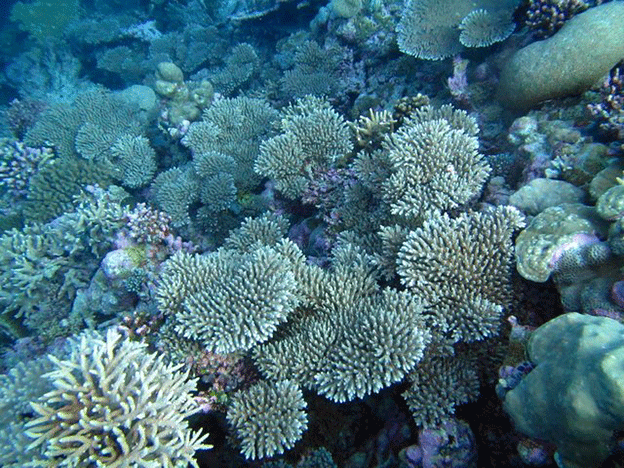 |
Acropora vermiculata |
Another place that doesn’t have too many species is Hawaii, which also has about 65 species. I learned corals in the Caribbean, because I needed to know what the corals were, to survey reefs. I wanted to survey reefs that had never been surveyed before. Then I switched to Hawaii because it had relatively few species, there was some taxonomic study of them previously that I could use, and there were lots of tourist snorkelers and divers. I ended up writing a guidebook to the corals of Hawaii. Much of the rest of the Pacific and Indian Oceans have a lot more coral species, and places like the Philippines and Indonesia have a bewildering variety of corals. You want all the best books you can get on coral identification to help you.
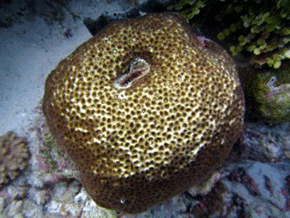 |
Leptastrea bottae |
Corals are tough; you need all the help you can get. Corals are tough because they are so variable. They seem a little bit like dogs. There are lots of dog breeds, but there are also lots of dogs that are part this and part that, and don’t fit any one breed very well. Corals seem to be like that, and in fact some scientists have some evidence that they can interbreed sometimes, a bit like dogs. The master book is a series of 3 books published in 2000 called “Corals of the World” by Veron. I used to work for Veron, and if you read the fine print in those 3 books, you’ll see a few pictures were taken by me (about 80 out of 3000 or so!). Also, there are 7 species in the book which Veron and I named together because we discovered them. Some corals look different in different places, which makes it harder to figure them out. As you look in the books and look at living corals, you will probably see ones that don’t match anything in the books. Then it’s time to get more serious about the science of coral species, called “taxonomy.” Coral species are defined based on their skeletons. The live tissues cover the skeleton, and in most species are thin enough you can see the shape of the skeleton. But to really identify a species, you need to study the skeletons. There are books, monographs, and papers that describe the skeletons. You may find those in libraries or in a few cases online. They use some technical terms, and usually have photographs of the coral skeletons. The more you pursue coral identification, the more you need to consult these.
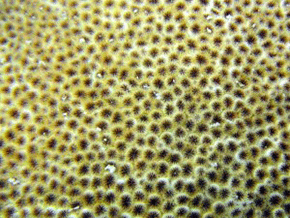 |
Leptastrea bottae |
I am always eager to learn to identify corals that I couldn’t identify before, and when I do learn a new coral, it is a great feeling. I can think of a couple right away that I’ve learned here in Chagos so far. One grows as a round mass, and the other is branching. The one that forms rounded masses is named “Leptastrea bottae.” That species has been bothering coral taxonomists for some time. First one type of living coral was thought to be that species, but then it was found to already have another name. Then no one knew what the living species “L. bottae” looked like. Veron, in “Corals of the World”, showed some close up pictures of living colonies and stated that they are round masses. Most species in the genus “Leptastrea” are flat and thin, rather like paint. I was seeing round masses here that clearly had the features of Leptastrea and looked a bit like a species I’m familiar with. I was looking at the Veron book, and suddenly it hit me that I was looking at “Leptastera bottae.” I took plenty of photos of the whole colonies as well as close-ups. Now that I know what it looks like, it will be easy to identify! Often corals are hard to figure out, but once you figure them out, they become much easier. Some just remain troublesome.
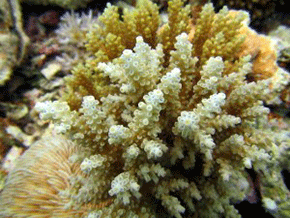 |
Acropora vermiculata |
The branching coral forms cushion-shaped colonies about a foot or so in diameter, with most branches growing upward. The polyps live in little cups in all corals, and in this species the cups are a little like leaves extending out from the branches. The shape and size of the polyp cups is very helpful in coral identification. I thought it looked like a species named “Acropora tenuis”, but it didn’t seem to be quite right - the match wasn’t perfect. Another team member and I were discussing it, and he flipped the pages from Acropora tenuis to the left in the book. I had been looking to the right. First page to the left and there were the cushion-shaped colonies, and the branches have the right shaped polyp cups. Bingo!! We found it! Good match. “Acropora vermiculata.” I had never identified that species before in the water. Now that I know it, it is easy. You build up your knowledge, one small step at a time. The journey to becoming a coral identification expert starts with one small species (to paraphrase a saying). Bon voyage!
Sunday April 6th: This is an expedition, not a vacation (holiday)
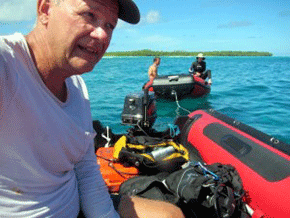 |
Dive gear on an inflatable |
Like most people, scientists have sunny days and rainy days. If you work on coral reefs, some days you dive in warm, sunlit, clear water with no currents and no wave surge. But not always. The last few days it has been stormy here in Chagos. We try to do two scuba dives in a day. Because it is a very remote location, the only way to access it is from a large mother ship which we live on, which carries small inflatable boats that are launched from the mother ship. The mother ship can’t get close to reefs without the risk of running aground, so we use the small inflatable boats to get to the reef, and dive from them. The reality is that there is limited space on ships, and the rooms are usually small and shared - some are positively tiny. If there are large waves, the ship rocks. I took Dramamine before boarding the ship to forestall sea sickness. After about 24 hours I get used to the rocking ship, but, particularly when you are carrying steel scuba tanks that weigh about 45 pounds, it is wise to be very careful.
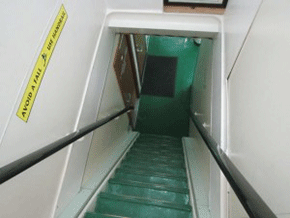 |
Steep stairs |
Ships also typically have very steep stairways (to save space), and high door thresholds going in and out of the ship. This is so a water-tight door can be locked securely shut, in case the waves get enormous. We have to carry empty tanks to the bow, where the compressors fill them, and then carry full ones back to the stern where we launch the small boats. Further, the small rubber boats have to be hoisted with a crane off of the large stern working deck and into the water. The divers also have to walk
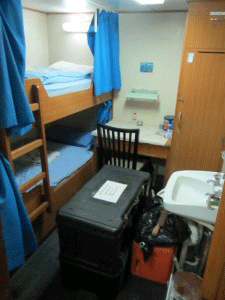 |
Ship's cabin |
down a rope ladder down the side of the ship to the inflatable boat, which bobs up and down with the waves. The opportunities for accidents are all over. Once on the rubber boat, you motor off, riding on the inflated tube, often holding on for dear life. It’s a little like driving in a small car that has no top or walls or doors, no seatbelt, no seats, you sit on an inflated tube and hold on for dear life as you drive over bumps that are 1-3 feet tall.
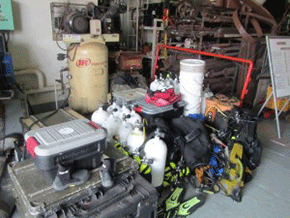 |
Dive equipment |
Scuba diving itself has many serious dangers, which can largely be avoided with training and safe practices. We not only have an extra mouthpiece attached to our tanks so any diver out of air could use it, we also have a second, smaller “pony tank” with its own mouthpiece in case we run out of air. We have a pressure gauge that tells us how much air pressure we have left, much like a fuel gauge on a car. There are many more safety practices we use with the scuba and boats to keep them as safe as possible. Then a day like today comes, we get up before dawn to get all of our equipment ready. The two tanks plus buoyancy vest, mouthpiece, and “regulator” that gives us the right pressure of air, all together must weigh 60 pounds or so. Under water it weighs much less. After we have had breakfast, we put our gear into the boats and the boats are launched, we get in and drive off, anchor at the reef and put our gear on, and roll overboard into a sea that still almost looks black. Remember, the sky is a dark gray today.
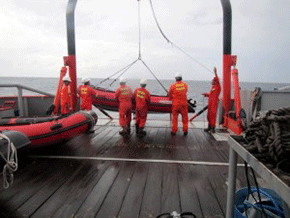 |
Launching an inflatable |
Underwater, there is plenty of light to see everything, and we go about our work. But sometimes, on the way to or from the reef, a squall hits and it pours rain and blows. At other times, the waves are too big to launch the inflatable boats, like this afternoon. Other times it is sunny and blue sky, and we work near an island with a white sand beach and palm trees. Sometimes we discover something new, and that is the best of all for a scientist. All the time we know we are gathering information that can help make good decisions to keep this wonder of the world healthy, so it is all worth it. Once we get underwater and settle down on the gorgeous reef and are surrounded by fish, we remember just how magical it is and lucky we are to see it. This is our office, and it is time to go to work. But we also know, with the threats facing reefs, we could be the last generation to see healthy reefs like this. It will take enormous efforts to save reefs, so it’s time for all of us to renew our efforts to save them.
Thursday April 3rd: Strangers in Paradise
I record coral species as I find them during my dive. There are two previous lists of coral species in the Chagos archipelago; one by Charles Sheppard and one by David Obura. Both have about 220 coral species on them, but about half the species on each list are not on the other list, so the total from both lists is about 310 species. When I get back on the ship, I compare the species I have recorded with those on my master list of the 310 species to see if any of the species I record are not on previous lists. Any that are not on those lists I call “new records for Chagos.” At the moment, I have 32 such new records. In addition, I’ve compared the list of species I’ve recorded so far with the known ranges of coral species, published in a set of three volumes called “Corals of the World” by Veron (2000). So far I have found 16 species that are outside the published ranges.
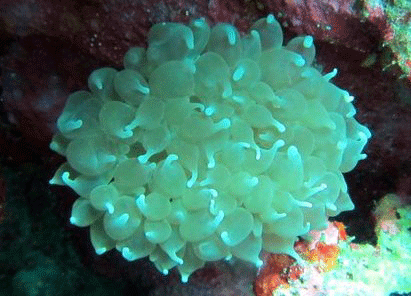 |
Plerogyra diabolotus |
A few of the species that I’ve recorded are particularly interesting to me. The most interesting is a species called “Plerogyra diabolotus.” This species was named relatively recently; in 2003 (people have been discovering and naming corals for over 200 years). At that time, it was known only from Borneo, Indonesia. Typically, a species is first discovered or recognized in one location or a small area, and then over time it is found in other places. Likewise, the known range of the species is usually small to begin with, but increases in size with time as scientists find it in additional places. The genus “Plerogyra” has just a few species in it, two of which are popularly known as “bubble corals.” That is because they are covered with what look like water-filled bubbles. One has bubbles larger than large grapes all over it, and the other has smaller bubbles at the ends of short branches. The one here in Chagos has small bubbles all over it, with a very short tentacle (so short it looks like a bump) on each bubble. In some colonies, the bubbles are retracted. You can see the shape of the skeleton, which is a meandering thick ridge with spaces between ridges, and some small blades projecting from the ridge. There is one species in another genus, “Physogyra lichtensteini”, which has small bubbles without tentacle bumps and the skeleton is continuous.
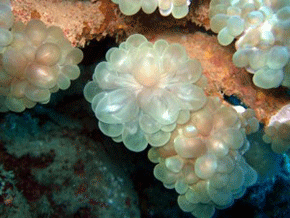 |
Plerogyra bubble coral |
When I first saw this coral, I thought it was Plerogyra, not Physogyra. When I saw the skeleton, I knew I was right on that. I thought it was an ordinary bubble coral, “Plerogyra sinuosa.” But it didn’t seem to match very well; the bubbles were too small and they had bumps on them. I had a vague memory of a paper that described some new species in the genus. Luckily, I have a copy of the paper on my computer. I found the paper, and took a look. The paper has pictures of both the live coral and the skeleton. Bingo! Looks just like it. Fun! I’ve never seen Plerogyra diabolotus before, and to my knowledge it hasn’t been reported outside of Borneo so far. The author wrote that it was so named because when the bubbles are apart, the bumps look like the pointed ears of the devil! Hmmm. You can name a species almost anything you want. Name it after how it looks to you, name it after someone, whatever. You have to put the name into a scientific format, Latinizing it. The first name that anyone gives a species in a publication is the valid species name, according to the rules.
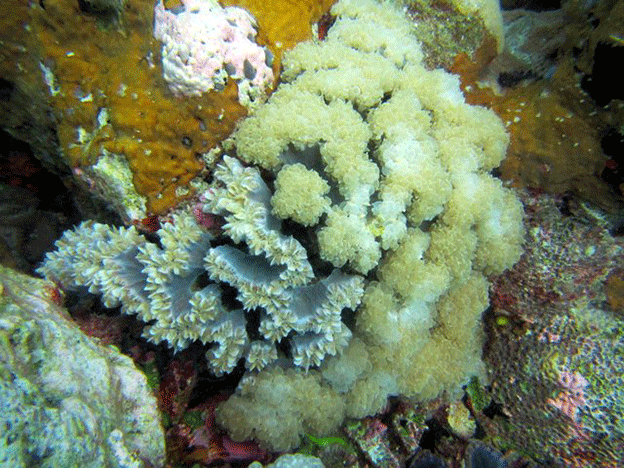 |
Plerogyra diabolotus |
Once a species is named, scientists can be sure what they are studying and can communicate clearly with other scientists and know whether they are studying the same thing or not. You can also use the number of species as a measure of the diversity, and study patterns in diversity using the number of species and the similarity of different communities of species. If you know the species, you can also tell if a place like Chagos has any unique species not found elsewhere, like the coral and anemonefish that were named after Chagos. You can actually learn quite a lot from lists of species from different locations.
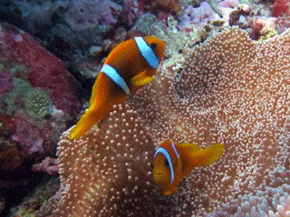 |
Anemonefish |
Correction: I wrote in a previous blog that the photograph of the anemonefish I took was the Chagos anemonefish. Anne Sheppard pointed out that there are several species of anemonefish here, at least one of which looks very much like the Chagos anemonefish. She pointed out that the critical distinction is that the upper part of the white bar near the head narrows to a point, while it does not in the other species. Clearly, my photo was of the other species. My apologies. I like fish but I’m not a fish taxonomist. The ID guide I used showed an orange fish labelled “Chagos anemonefish” and the other was shown in a dark phase. Anne points out that they have a variety of shades between orange and dark, and color isn’t useful for distinguishing the two. This sort of thing is typical with many species of coral, and we live and learn. Science is often a process of adding to and improving our knowledge. Thanks, Anne! I’ll now look for the right one. Anne says they are not common, so I will have to be lucky to find one.
Tuesday April 1st: Reef Reality
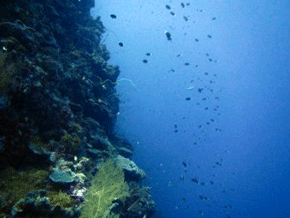 |
Reef wall |
We all tend to focus on the things in our surroundings that are important to us. Underwater, I’m studying coral species and coral disease. I record each coral species I find underwater on my slate, and I take pictures of each kind of coral so that I have at least a few pictures of each species of coral in Chagos. I also take pictures of extra pretty corals, of corals that I can’t immediately identify, corals that have disease, and other unusual organisms. Sometimes I remember to take a picture of my dive buddy, but not often. Other times I remember to take a picture of what the reef around me looks like, though often I forget to. But the truth is, we need to take data, and I can easily get so wrapped up in my specialty, that I forget to “smell the flowers” and take pictures of what the reef looks like.
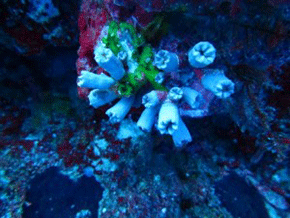 |
Coral image using natural light |
When I first started diving, there were no digital cameras, only film cameras. The only way to get good color under water, was to use flash. You could get gorgeous colors by using slide film, if you used flash and got the flash adjusted right. But it only worked if you were fairly close to your subject, say 2 feet or less. If you tried to take a picture of a scene on the reef, you were likely to get something that looked like it was taken at night (close things brightly lit, everything else too dark to see), nothing like what you saw. Not nearly as pretty. But digital cameras can do a pretty good job of taking a picture of a scene that looks a lot like what you see. You have to do “white balance” to get those pictures.
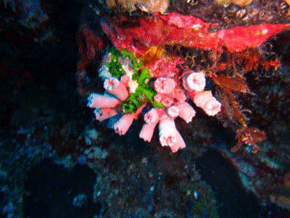 |
Coral image using a flash |
Atolls are coral rings. The ring can have narrow sand islands, but also often has gaps in the islands, and if the gaps are deep they are called “passes.” The ship we are on, the “Pacific Marlin,” can go through those passes and anchor in the inside, which is called the “lagoon.” The lagoon is usually calmer than outside, making it easier to launch the inflatable boats to go to the dive sites.
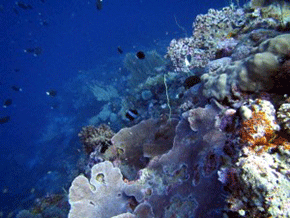 |
Reef lower slope |
The lagoons usually have sandy bottoms, but also often have coral knolls or patch reefs. The captain has to know how to navigate not to hit the knolls. Outside the ring, the bottom is shallow near the island or submerged ring, and gradually gets deeper. Often, there is a point, maybe around 10 meters deep, where the reef begins to drop off more steeply. Sometimes it goes down vertically, other times it goes down at an intermediate angle. I find the most coral species if I go down nearly to our depth limit of 25 meters, then spend my whole dive, usually one hour long, slowly working my way up, looking for coral species to record, interesting corals, and diseases. I do the same thing on coral knolls in the lagoons.
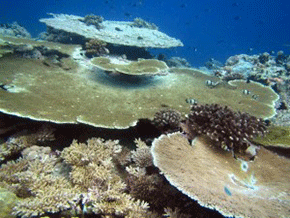 |
Reef upper slope |
Pictures of scenes of the reefs are one of the best ways to get an overall impression of the reality of the reefs. The blogs I have done so far have focused on very specific things on the reefs, and for the clownfish and the fluorescent corals, I focused on extra pretty things. They are a part of the reality of the reef, but only a small part. In scene photos you can see much more of the reality. Hopefully, you find it as fascinating as I do. We’ll talk about more parts of the reef in coming blogs.
Monday March 31st: Bright Coral Colors
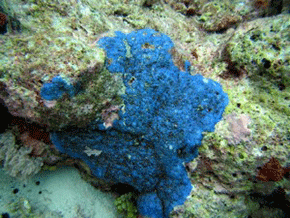 |
Brilliantly colored coral of the Chagos |
When we woke up today, it was raining hard outside, it was so cloudy it was still dark at 7am, so we waited and by 8 am the rain had stopped and it had started to clear. So we headed out in the RHIB’s (Rigid Hull Inflatable Boats, one common brand is Zodiac) to an outer reef slope. As we approached our site, we were greeted by spinner dolphins which swam with our boats (and faster!) and sometimes leapt and spun. They are one of the smaller species of porpoise. We had a fabulous dive in clear water. I saw far too many different things to tell you about all of them in one episode, but I’d like to tell you about one.
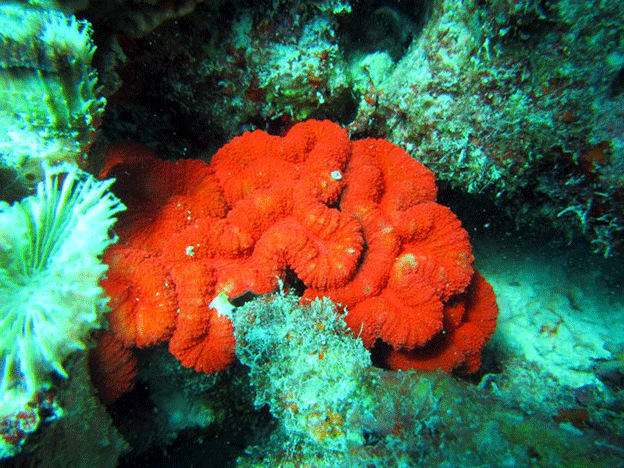 |
Many corals display 'day-glow' colors |
Corals come in a variety of colors. The most common colors for coral are shades of brown and green. This is because they host tiny, single-cell algae inside their cells. The algae cells make sugar in the presence of sunlight like all plants, and some of the sugar leaks out into the coral cells. This is a symbiosis that makes it possible for corals to grow rapidly and build giant coral reefs. The single-cell algae have yellow, brown, and green pigments in them, which give the coral its color. But a few corals come in other colors, and some have a variety of colors within a single coral. Colors other than brown or green come from pigments in the coral cells. A few corals come in many of the colors of the rainbow, and a few are especially brilliant colors that almost seem to glow. They seem too bright, like “day-glow” colors, the bright oranges and yellows that road workers often wear to make themselves more visible. Those colors in objects made by humans are produced by fluorescent pigments. They absorb ultraviolet or blue light, and then re-emit light that is orange or yellow. These corals seem to be doing the same thing. Some are bright green, and others are brilliant red or brilliant blue.
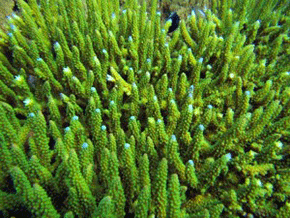 |
A coral displaying a common green color |
I love taking pictures of them, since they are so beautiful. But the bright pigments may also serve a purpose for the coral, by absorbing harmful ultraviolet rays which can damage corals just like they can cause sunburn in humans. In the tropics where corals live the ultraviolet rays are intense and can both give humans sunburn and damage corals. So the corals may be using these bright colors as sunblock!!! Pretty smart, eh? Corals are marvelous, incredible creatures that are quite different from us, and we keep learning fascinating things about them. In addition, they are beautiful and produce one of the most popular ecosystems in the world to visit. On a coral reef, you can see more wild animals, closer up, and easier, than virtually anywhere else in the world, and millions of divers have seen it and can’t wait until their next trip to see more of them. It is truly magical to be floating in gin-clear, warm water, surrounded by colorful fish flitting about colorful corals. A wonder of nature, a wonder of the world. OK, I admit it, I love coral reefs. So will you if you see one. Let’s keep them healthy so we can keep enjoying them, and our children and grandchildren can enjoy them too.
Saturday March 29th: Only in Chagos
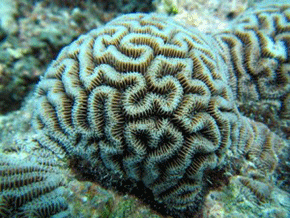 |
Ctenella chagius, found only in the Chagos |
Sorry I haven’t written for a few days, but I haven’t had a moment’s spare time to write. The expedition has started and is now well under way, and we are busy every minute of the day and exhausted and sleeping at night.
We are at Salomon Atoll, which is north of Diego Garcia and south of Great Chagos Bank. Some of our dives are on the outside of the ring on little islands that make up the land part of the atoll. On the outside, the water is crystal clear, there are lots of coral, and often the reef descends steeply below about 15 m deep. Other dives are inside the atoll, in the lagoon, where there are knolls that rise from maybe 30 m deep up to around 5 m deep. On some of both kinds of reefs, I’ve gotten to see a coral I’ve never seen before in my life. That’s because the ONLY place in the whole world that it lives is in Chagos (and one other small bank relatively close). The scientific name for it is Ctenella chagius so it was named after Chagos. I’ve dove many places in the Caribbean, Pacific, and Indian Oceans, and never seen it, because it only lives in Chagos. It is a beautiful brain coral, with very uniform and precise features.
 |
Chagos Anemonefish (Amphiprion chagosensis) |
A second thing I was excited at seeing was a clownfish (or anemonefish) which only lives in Chagos, called the “Chagos Anemonefish” (Amphiprion chagosensis) for that reason. The first one I saw was a brilliant orange, with two vertical white bars. Gorgeous. Then on another dive, I found lots of them, but they were all dusky brown with just a hint of the orange. Today I found a few more that were brilliant orange. I took pictures of both types, but I particularly wanted to get a good picture of the orange ones, because they are so pretty. They only live in anemones, and if you find the anemone, you are sure to find the fish living in it. They stay in the anemone, which makes it easier to photograph them, but they face you most of the time, and flit about quickly as the wave surge moves them back and forth. That makes it quite hard to get a photo of them from the side, which shows off their brilliant colors. I got a moderately good photo, but when I see them again I’ll try to get a better photo.
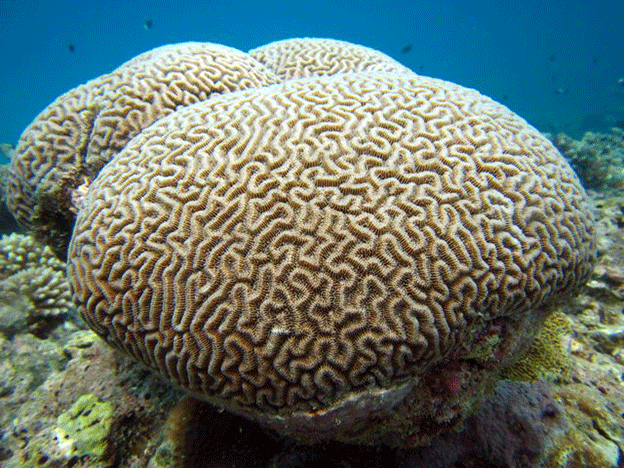 |
Ctenella chagius |
These species which are only found in Chagos are part of what makes this place so special. But there are many other things, which we’ll talk about in future additions to this story.
Sunday, March 23 : The Atolls of Chagos
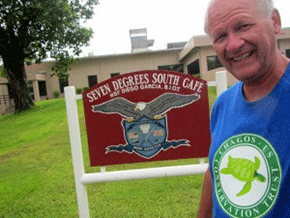 |
Doug visiting Seven Degrees South Cafe |
I’m sitting in my room today, it is too stormy outside for us to get much done today. I just was given a pdf copy of an article on the fish of Chagos. It reports the total weight of coral reef fish per unit of area of the coral reef. The atolls of Chagos have six times or more of the total reef fish weight of any other reefs around the Indian Ocean, including in areas where reefs are protected from fishing (Marine Protected Areas, MPAs). Not only that, but it has the highest reported reef fish weight per unit area of any reef in the world!!!! Diego Garcia, where I am at the moment, has considerably less. This is because Diego Garcia has people and the other atolls don’t. It is also because the Chagos archipelago is a large area, which has never been fished much. It is much larger than any of the MPAs elsewhere in the Indian Ocean. Large reef fish often roam around, and can swim outside of a small MPA and get caught. Interestingly, the second highest reef fish biomass area known is a small island in the Caribbean, part of Mexico, called “Cozumel.” I used to dive Cozumel a lot, long ago!!! I saw those fish and thought they were fabulous, there were so many. The reefs there have been in a very well enforced MPA since 1960 and weren’t depleted by fishing before then. I even published counts of how many individual fish there were per unit area. I was just learning to estimate fish size, which you need to do to estimate total biomass, when I shifted my research to Hawaii. Back then I didn’t know that biomass is important.
Wow, now I’m even more excited than I was that I’m going to get to see the Chagos atoll reefs! I get to study one of the world’s largest coral reef wildernesses, which has the world’s densest population of reef fish!!! Unbelievable opportunity of a lifetime! Pristine wildernesses like Chagos are the only way we know what natural undisturbed reefs are like, and how much we have damaged reefs around the world and how much we need to do to restore them. Chagos is incredibly valuable, a treasure for the whole world!
Friday, March 21, 2014: In the middle of a very big Indian Ocean on a tiny bit of land.
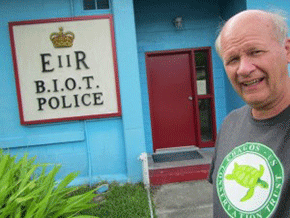 |
Doug outside B.I.O.T. police station in Diego Garcia. |
I arrived in Diego Garcia, Chagos, several days ago, as part of an advance party for the Chagos biological surveys. Nine more people will arrive in a few days. Meanwhile, Dr. Charles Sheppard, our leader and a very experienced Chagos expert, is meeting with various officials, briefing them and getting various things arranged. At the same time, Jon Slayer is leading the effort to locate and check all of the stored equipment, and arrange for many things such as fuel for our dingies that we will dive from, oil, and so on.
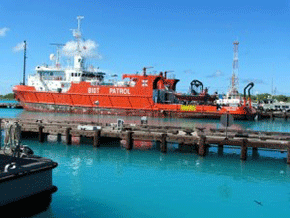 |
“Pacific Marlin,” the BIOT (British Indian Ocean Territory) patrol boat. |
Meanwhile, the “Pacific Marlin,” the BIOT (British Indian Ocean Territory) patrol boat has pulled in to port. She’s painted a brilliant orange, and is a beautiful sight. She’s larger than I imagined, and clearly a working ship. I see it has two fire hydrants for fighting fires. It has a big stern deck for all types of work. Dr. Sheppard led us aboard to go up to the bridge and meet the skipper and others, who were very welcoming. Dr. Sheppard has high praises for the crew.
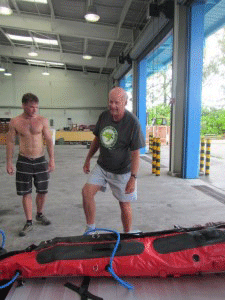 |
Inflating the two brand new inflatable boats. |
It is warm and very humid here, and rains periodically. The accommodations and food are nice. The rain stopped a minute ago, so I went out and got a couple pictures of signs to prove I was here. I believe we will be loading everything on the ship on Tuesday. Then we will cruise north and start diving on the atolls. I can’t wait. There is a little yacht club here on the lagoon side of the island with little sailboats, and the water is gorgeous.
I’m just back with helping Jon, Charles, and Courtney inflate the two brand new inflatable boats, carry them to the water, carry the engines to them and put them on, and tie them up to the wharf. Hot work. Back to the room, a nice cool shower, and I’m refreshed. I can’t wait to start the diving surveys!
March 9th 2014: How to get to Chagos!
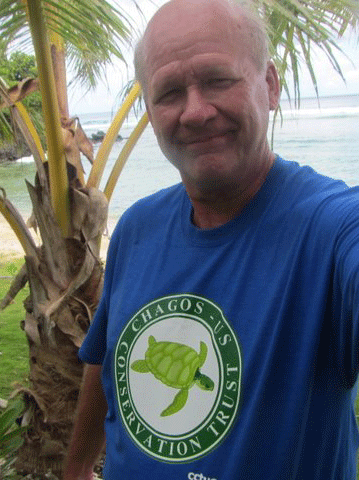 |
CCT-US Expedition Scholar Doug Fenner departing American Samoa |
Hello, my name is Doug Fenner, and I have the great good fortune to be able to join the expedition to Chagos. I’m an expert in coral species identification, and I will be identifying coral species and recording coral disease. But I am a long ways away from Chagos now, as I start my journey. You see, I live in American Samoa, a volcanic rock island 17 miles long, near the middle of the Pacific Ocean. The island is as far south of Hawaii as London is from New York.
There are no civilian flights to Chagos. The only flights there are US military cargo jets that fly from either Singapore or, as in our case, Bahrain. I believe Bahrain is almost the opposite side of the world from American Samoa. Due to some slight confusion when the travel agent booked my flight, my journey starts with a short hop across the international date-line into the independent nation of Samoa (formerly Western Samoa). From here it will take me about 3 days just to get to Bahrain, with stopovers in Auckland, Brisbane, and Singapore. All before another 14 hour flight to Chagos. You can see it helps to have a sense of adventure on this sort of trip.
I’ve been to quite a few different places in the Caribbean, Pacific, and Indian Ocean to study corals, and I love it. I have a list in my laptop of things to bring, and I review it several times in the weeks before I go on a trip, checking that I have everything. I have two sets of reading glasses (I can’t read without them), two sets of sunglasses, and two swim suits. I can get stressed before a trip, worrying that I have everything and haven’t forgotten something. There are lots of critical pieces, and if you get to a remote reef to do research and don’t have an important component, you are out of luck. Almost everybody who SCUBA dives has forgotten something like their mask or fins when they got on the boat and have to go back. But from Chagos, there is no going back. So I have a full set of scuba equipment packed, minus the scuba tanks and weights, which are supplied on the research vessel.
 |
CCT-US Expedition Scholar Doug Fenner arrives in Bahrain |
On the flight from Singapore to Bahrain I was sat next to a fellow from Ireland, and we had great conversations about a lot of things. He had just tried diving in Thailand, and loved it, and is planning on taking a course to get his certification. Most people who try a dive on a coral reef get hooked. These days SCUBA diving is big business. Sustaining a significant portion of the tourist trade that brings much-needed money to many islands in the Caribbean, Pacific, and Indian Ocean. In the Red Sea, I believe diving tourism now brings Egypt as much or more income than the great pyramids! We all hope that the great value of coral reefs will not be lost on the countries and people who depend on them, and they will have an incentive to take care of them.
Arriving in Bahrain, I make my way to the hotel and rendezvous with Prof. Charles Sheppard, the highly respected British coral reef scientist and leader of the Chagos expedition, as well as the rest of the science team.
The final leg of my journey is booked on a military flight out to the naval base on Diego Garcia. This flight has however now been delayed for several days. While this time has provided a good opportunity to recover from some of the accumulated jet lag, and discuss the prospects of the forthcoming expedition, I, like the rest of the team am itching to get to Chagos and begin our work under the water.
Though email and other communication is likely to be limited while on the ship, I will do my best to keep you all up to date with expedition exploits and findings.
Dr. Fenner's participation in the expedition is made possible in part from contributions by The Kayne Foundation, The Schnormeier Foundation and CCT-US members.

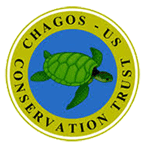 Chagos Conservation Trust – US
Chagos Conservation Trust – US